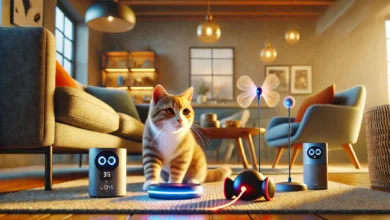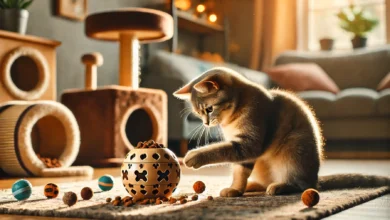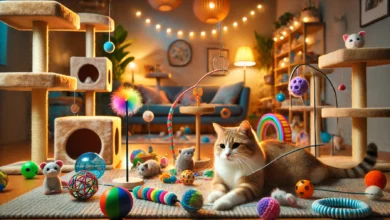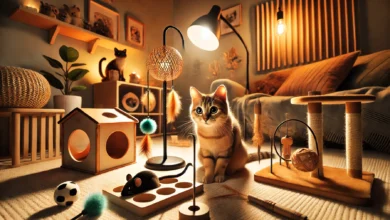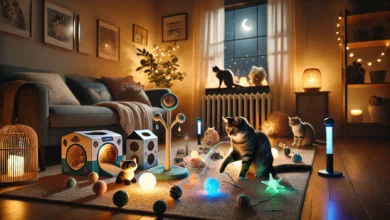How to Use Fitness Toys for Cat Exercise
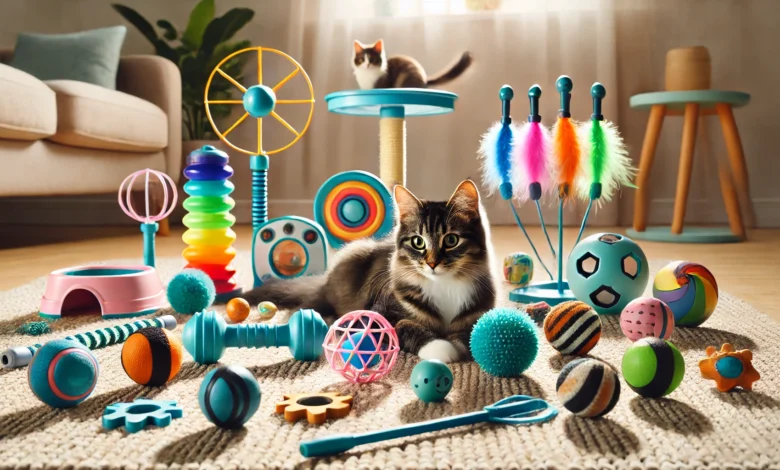
By nature, cats are an active species, hence playful and curious.
Keeping your cat busy, healthy, and away from troublesome activities requires more than just the basics.
Give your kitty some exercise.
That is where fitness toys come in.
Fitness toys for cats will help add some kind of physical activity to their daily routine in a fun manner, whereby they will be able to expend excess energy and act naturally as they would in the wild, while hunting or stalking.
Whether you have a kitten full of energy or an older cat that needs motivation to stay fit, fitness toys can make a huge difference in the overall well-being of your cat.
In this article, we will explore how to keep your feline friend active, happy, and healthy by incorporating fitness toys into their lives.
Table of Contents
Fitness Toys for Cats: An Introduction
Fitness toys for cats are more than just a source of fun; they also play an important role in maintaining your cat’s physical and mental activity.
As every cat owner will confirm, felines get bored quickly.
By nature, cats are predatory, and they have a natural need to chase, attack, and investigate.
Fitness toys will emulate these experiences, providing them with exercise and the mental stimulation they need.
Why are fitness toys so important for your cat?
Indoor cats, for example, have limited opportunities to engage in natural behavior.
Without regular exercise, they may become overweight or develop behavioral issues, such as scratching furniture or over-grooming.
Fitness toys can help alleviate these problems by promoting active play and problem-solving skills.
They not only benefit your cat’s physical health but also improve their mood and relieve stress.
Fitness toys keep cats physically active and mentally stimulated, preventing boredom and encouraging natural behaviors like hunting and chasing.
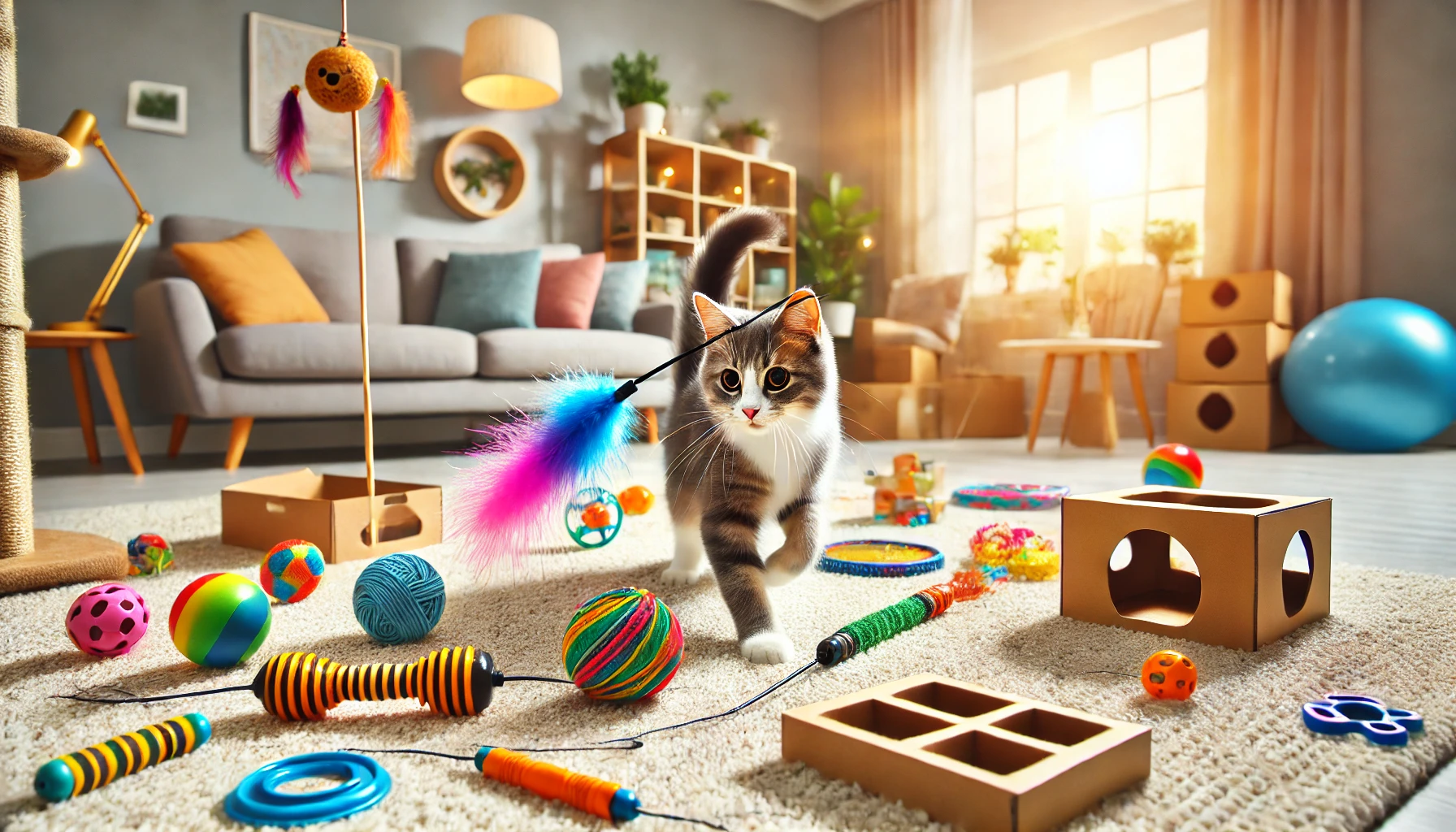
Why Fitness Toys Are Important to Your Cat’s Health
Like humans, cats need exercise to maintain a healthy weight and avoid obesity-related health problems.
Regular play sessions with fitness toys help manage their weight by burning extra calories.
In addition, these toys strengthen muscles, improve agility, and promote physical fitness.
A healthy, active cat is less likely to develop health issues such as diabetes, arthritis, or heart disease, making fitness toys an essential part of your cat’s life.
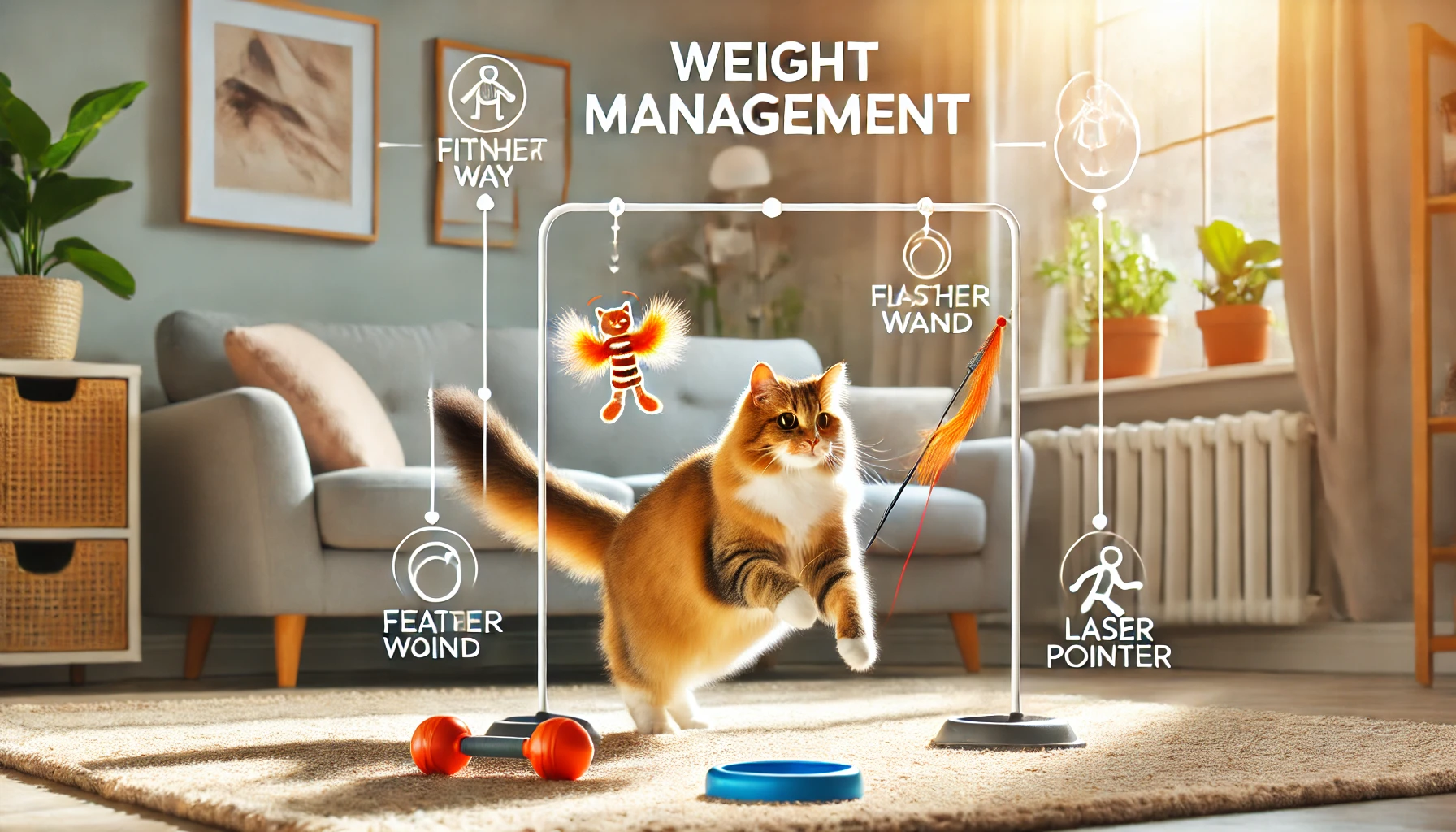
Weight Management
Playing with fitness toys regularly helps burn calories and keeps cats from becoming obese.
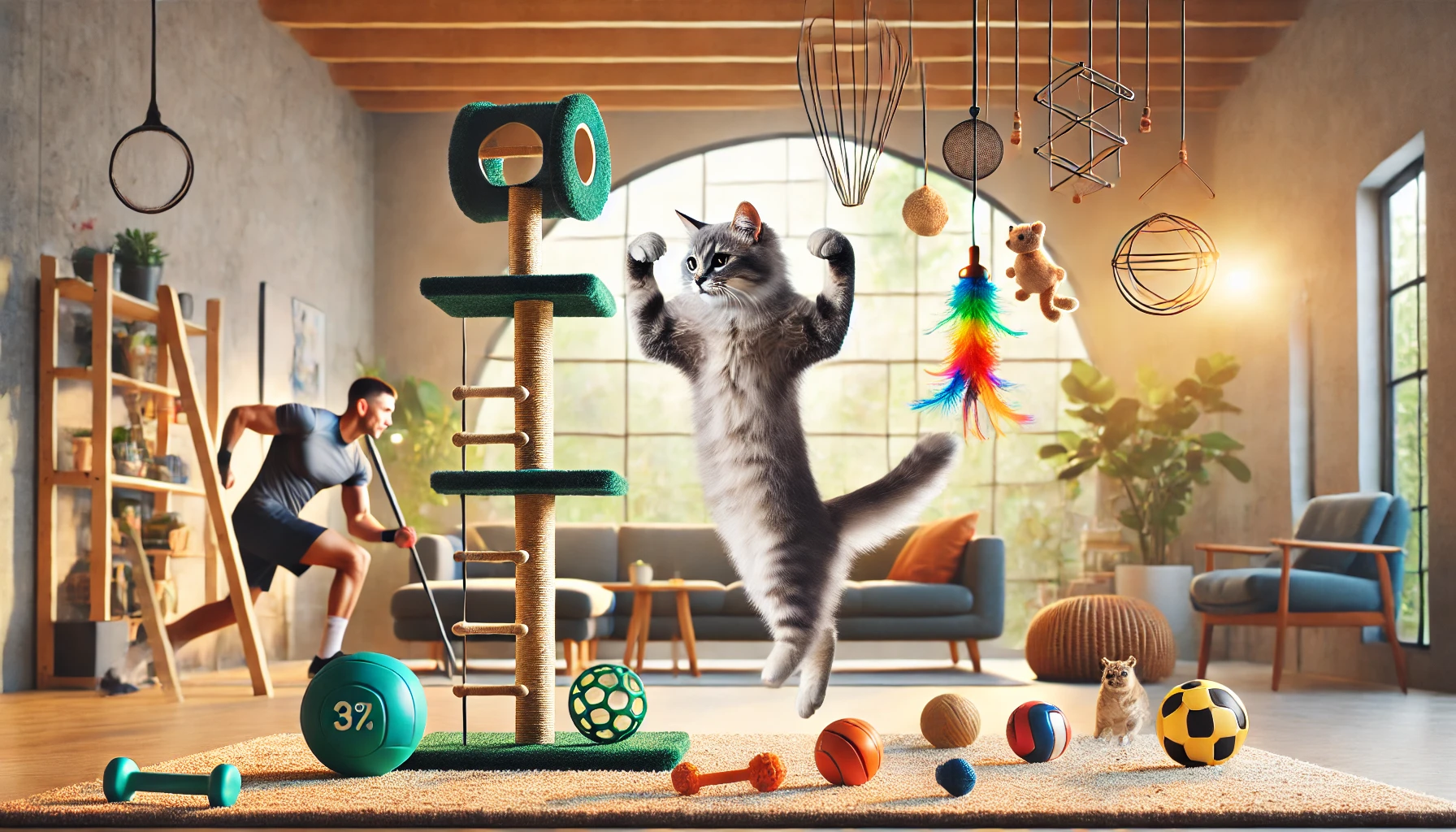
Development of Musculature
Fitness toys encourage your cat to jump, chase, and climb, which strengthens muscles and joints.
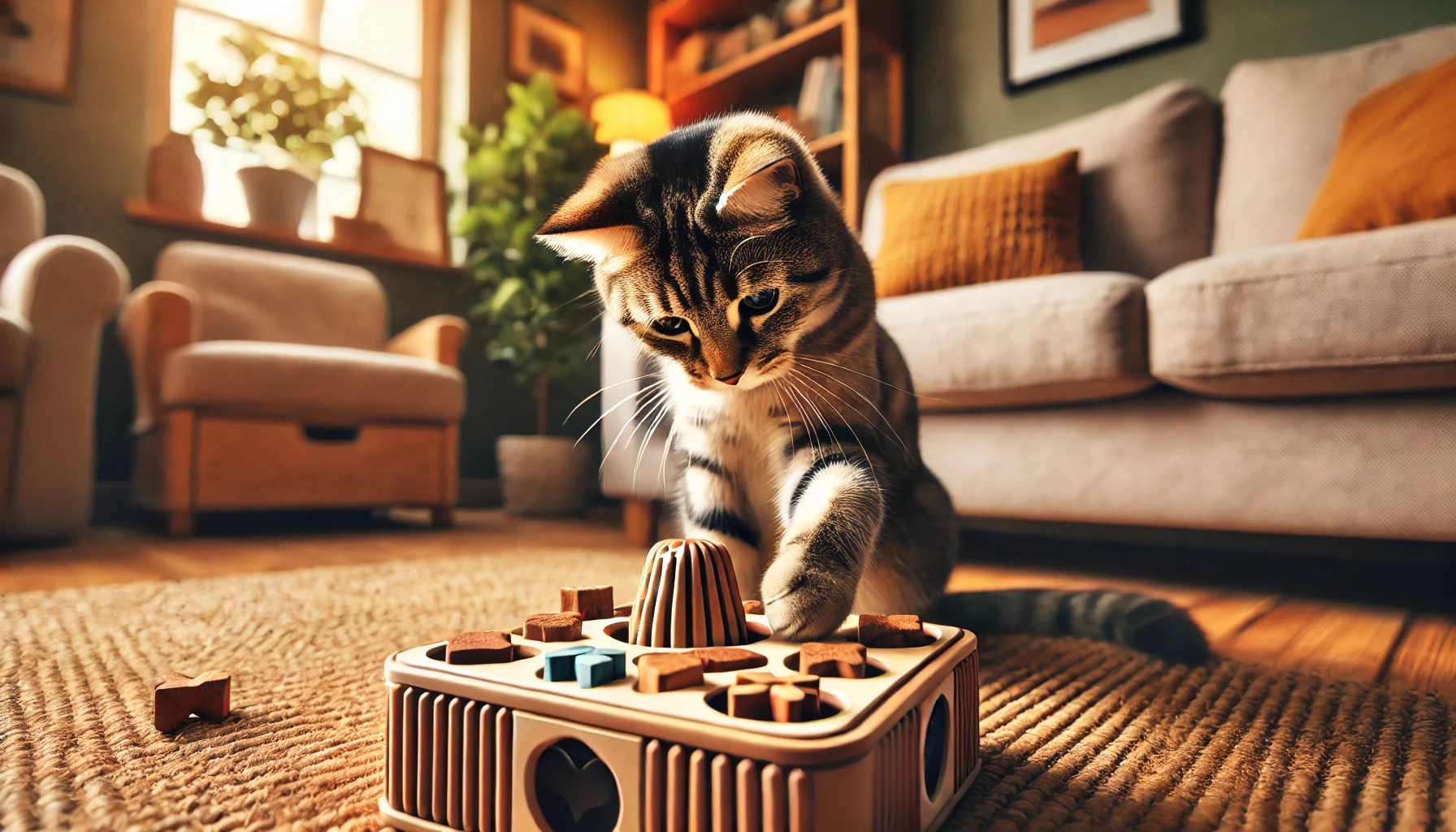
Mental Stimulation
Toys that challenge your cat mentally, like puzzle feeders, prevent boredom and reduce behavioral problems.
Regular use of fitness toys helps manage your cat’s weight, strengthens muscles, and improves overall agility and health.
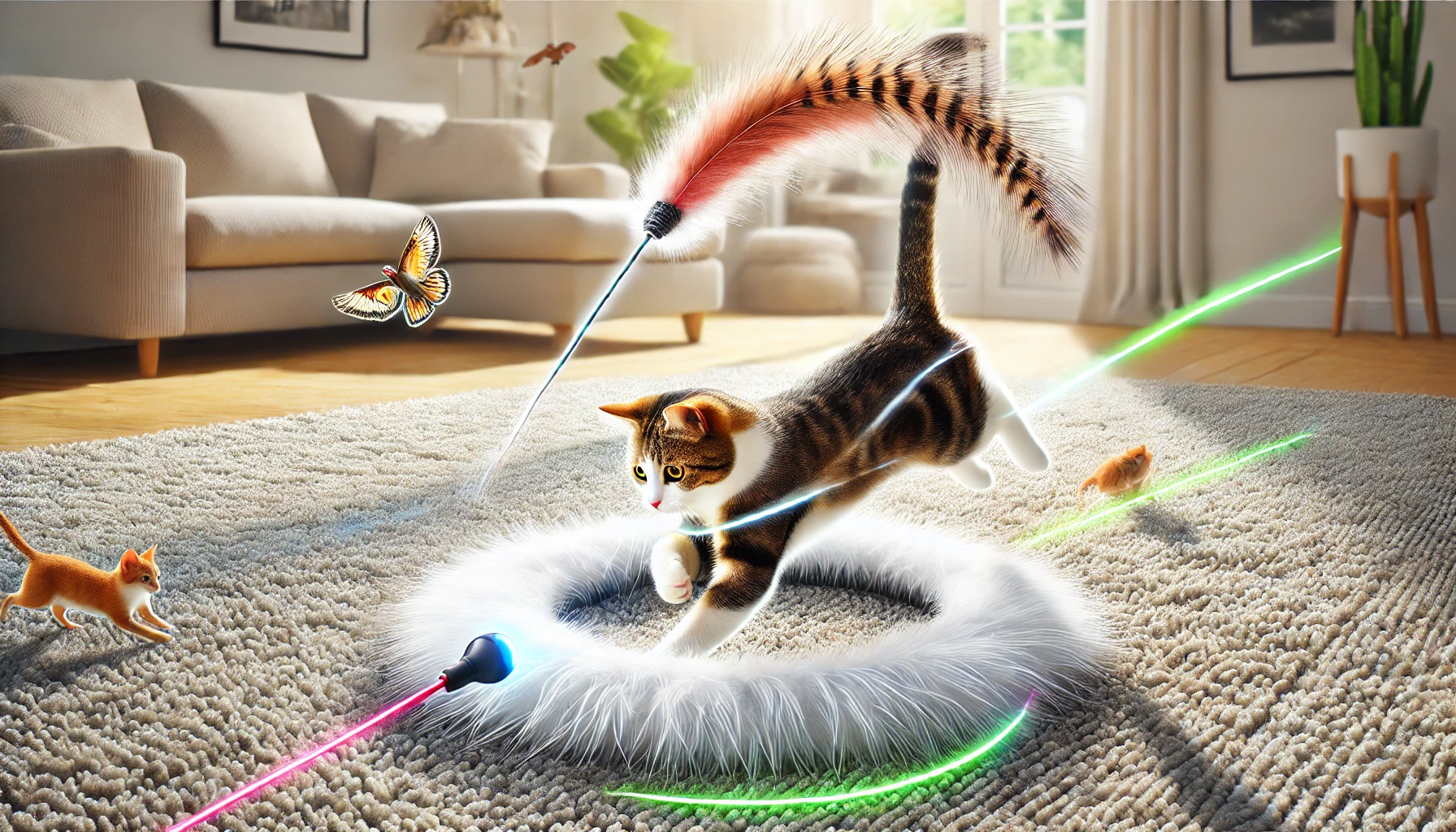
How Fitness Toys Imitate Natural Cat Behavior
Cats are natural predators, and their play behavior reflects this instinct.
Fitness toys can mimic the movements of prey, like a mouse darting across the floor or a bird fluttering through the air.
These toys trigger your cat’s instincts, encouraging them to follow, leap, and stalk their ‘prey.’ Interactive toys, such as feather wands and laser pointers, replicate these movements, keeping your cat both fit and mentally stimulated by satisfying their natural hunting instincts.
- Feather wands: Mimics the fluttering of birds, enticing your cat to leap and chase.
- Laser pointers: Encourages your cat to follow and pounce, like small animals in the wild.
- Interactive balls: These rolling toys simulate the erratic movement of a mouse, exciting your cat to chase and ‘hunt.’
Fitness toys like feather wands and laser pointers simulate natural hunting instincts, encouraging your cat to stay active and entertained.
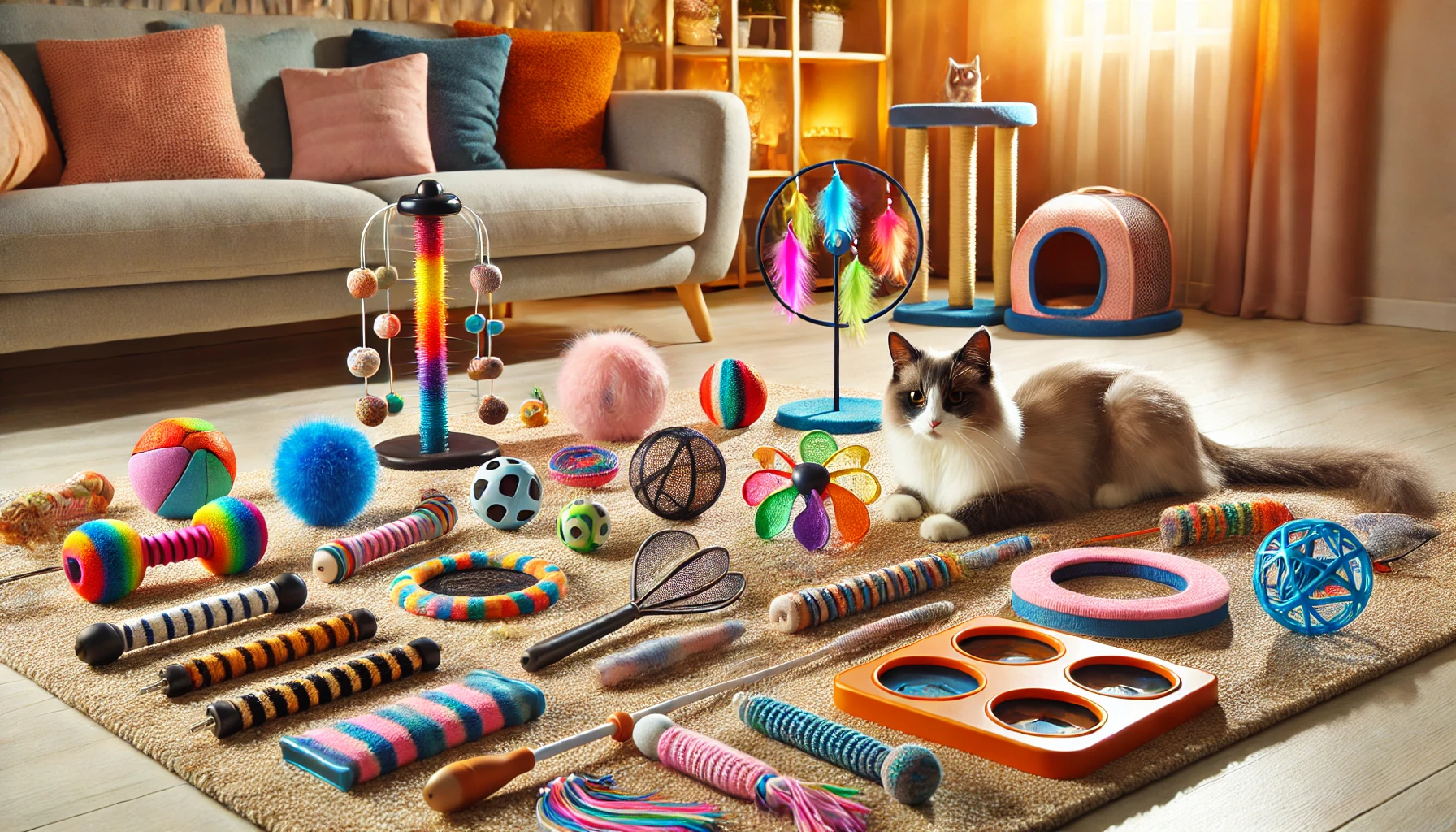
Types of Fitness Toys Available for Cats
There are several types of fitness toys available, all designed to stimulate your cat’s instincts and get them physically active.
They range from interactive toys that require your involvement to automated ones that can be used independently by your cat.
The right type of fitness toy can make a big difference in your cat’s motivation and entertainment, especially if they are indoor cats that don’t get enough natural exercise.
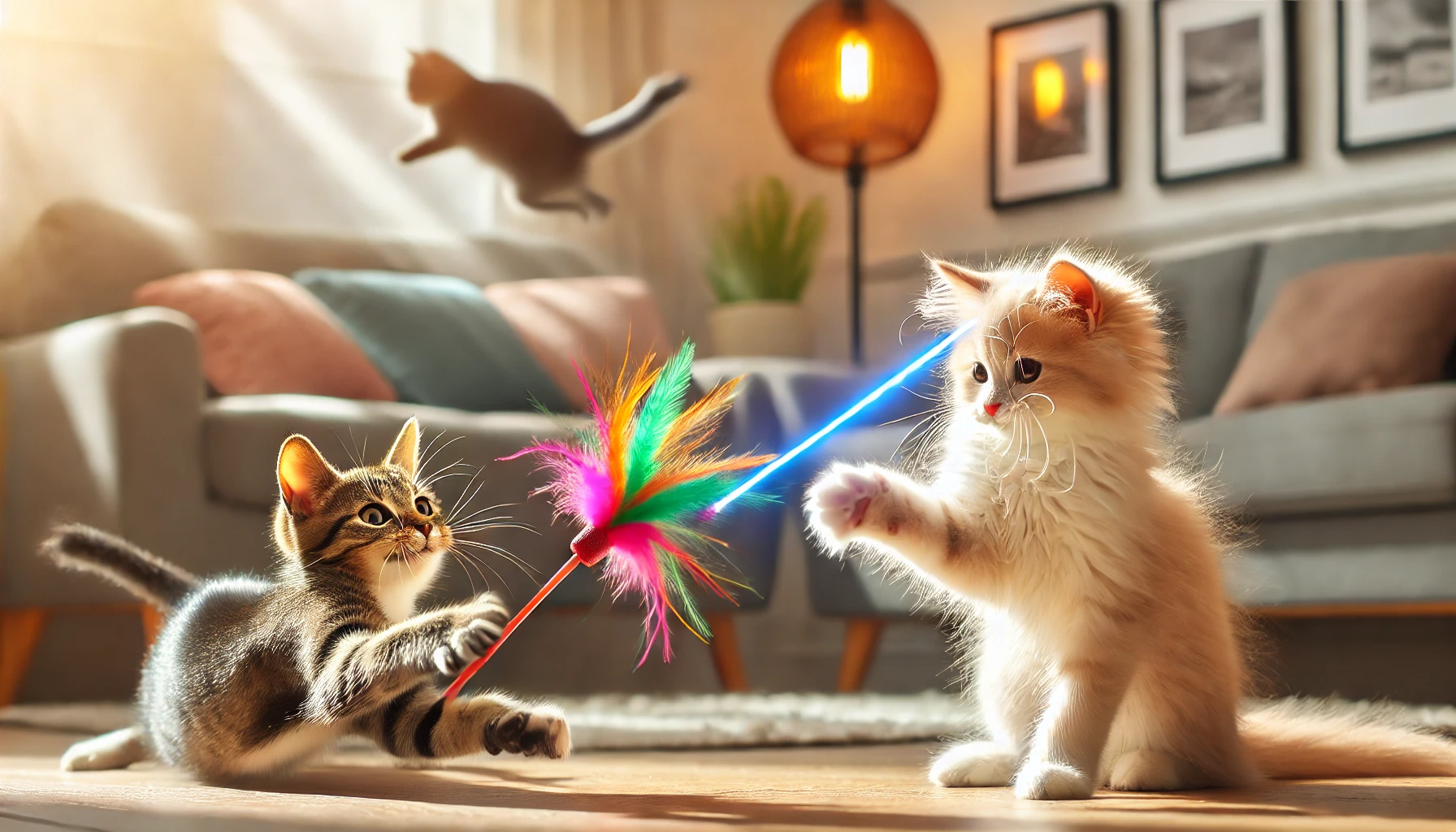
Interactive Toys: Laser Pointers and Feather Wands
Interactive toys are those that allow you to engage directly with your cat.
The most common examples are laser pointers and feather wands, both of which create the illusion of prey for your cat to chase and jump after.
These toys not only provide excellent physical exercise but also strengthen the bond between you and your feline friend.
It’s important to finish sessions with laser pointers by providing your cat something tangible to catch, like a toy, to avoid frustration from endless chasing.
- Laser pointers: Encourage stalking, pouncing, and fast-paced chasing. Ideal for high-energy cats.
- Feather wands: Mimic bird-like motions to satisfy your cat’s natural hunting instincts.
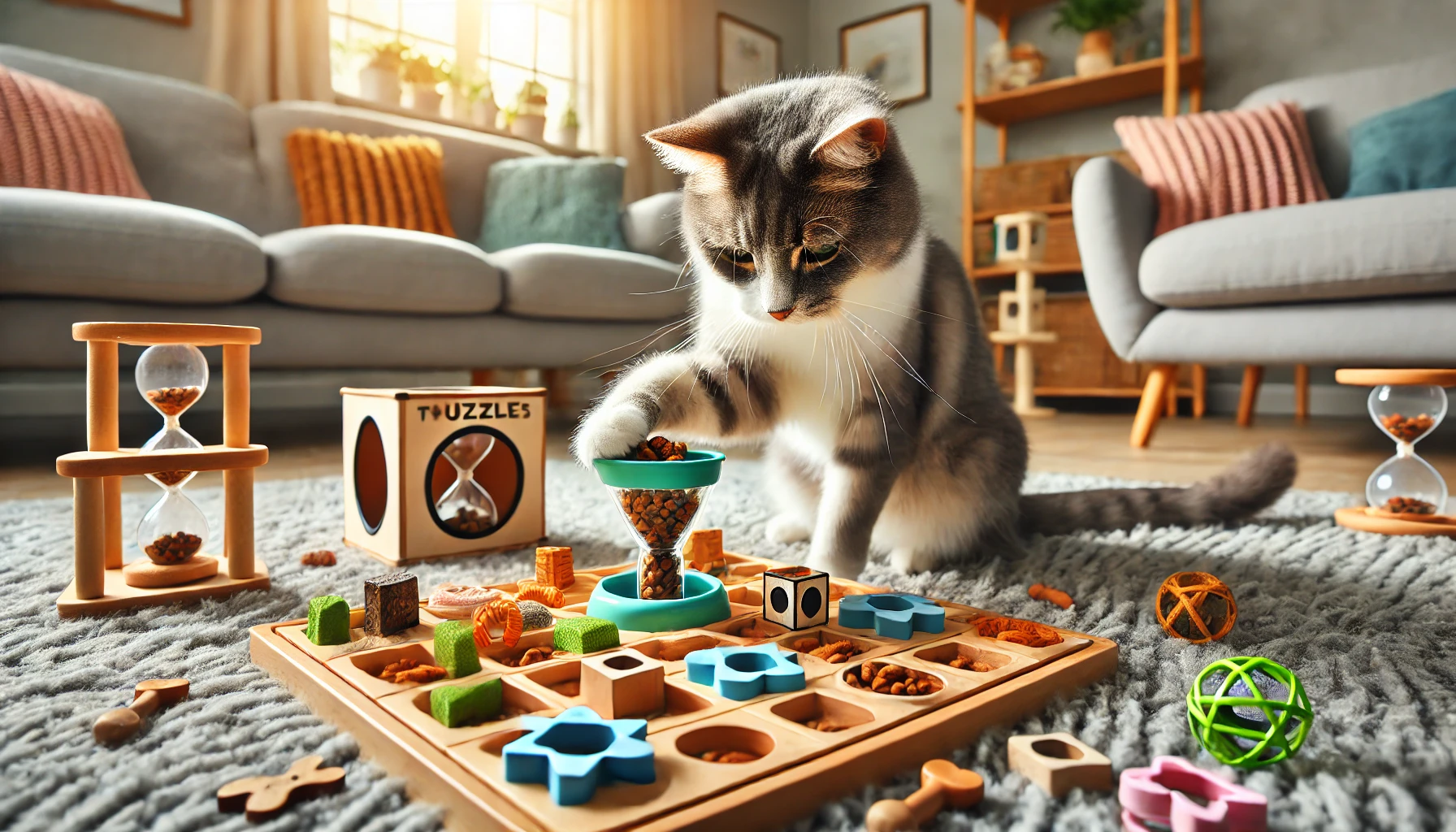
Active/Challenge Toys: Puzzle Toys and Treat-Dispensing Toys
Puzzle toys and treat-dispensing toys provide both mental stimulation and opportunities for exercise.
These toys challenge your cat to solve a problem or work for a treat, making them especially valuable for cats that need extra mental stimulation.
Puzzle toys can help minimize boredom and keep your cat entertained for extended periods, while treat-dispensing toys give your cat a tasty incentive to stay active.
Food-motivated cats particularly enjoy these types of fitness toys, as they combine playtime with a snack.
- Puzzle toys: Mentally stimulate and physically engage your cat as they work to solve the challenge.
- Treat-dispensing toys: Reward your cat with treats for solving puzzles, encouraging both physical activity and mental stimulation.
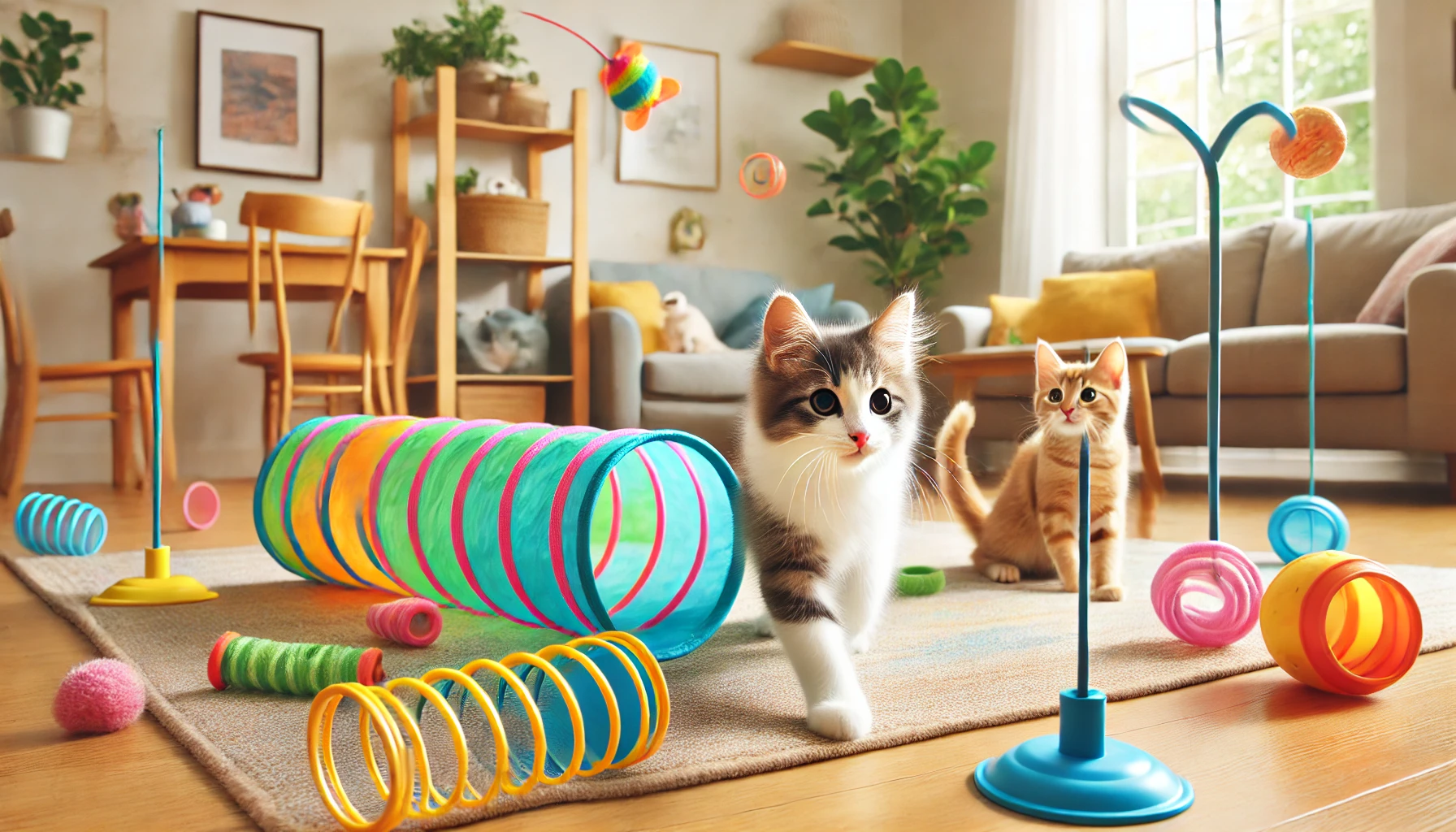
Active Toys: Tunnels and Springs
For cats that love darting around and exploring, active toys like tunnels and spring toys are perfect.
Tunnels give your cat a place to hide, dash through, and ambush their ‘prey,’ while spring toys bounce unpredictably, sparking your cat’s curiosity and encouraging energetic play.
These toys are great for cats that enjoy running and jumping and can even help multiple cats play together in a shared environment.
- Tunnels: Provide hiding spots and pathways for your cat to sprint through, creating bursts of energy.
- Springs: Bounce in unpredictable directions, encouraging your cat to chase and pounce.
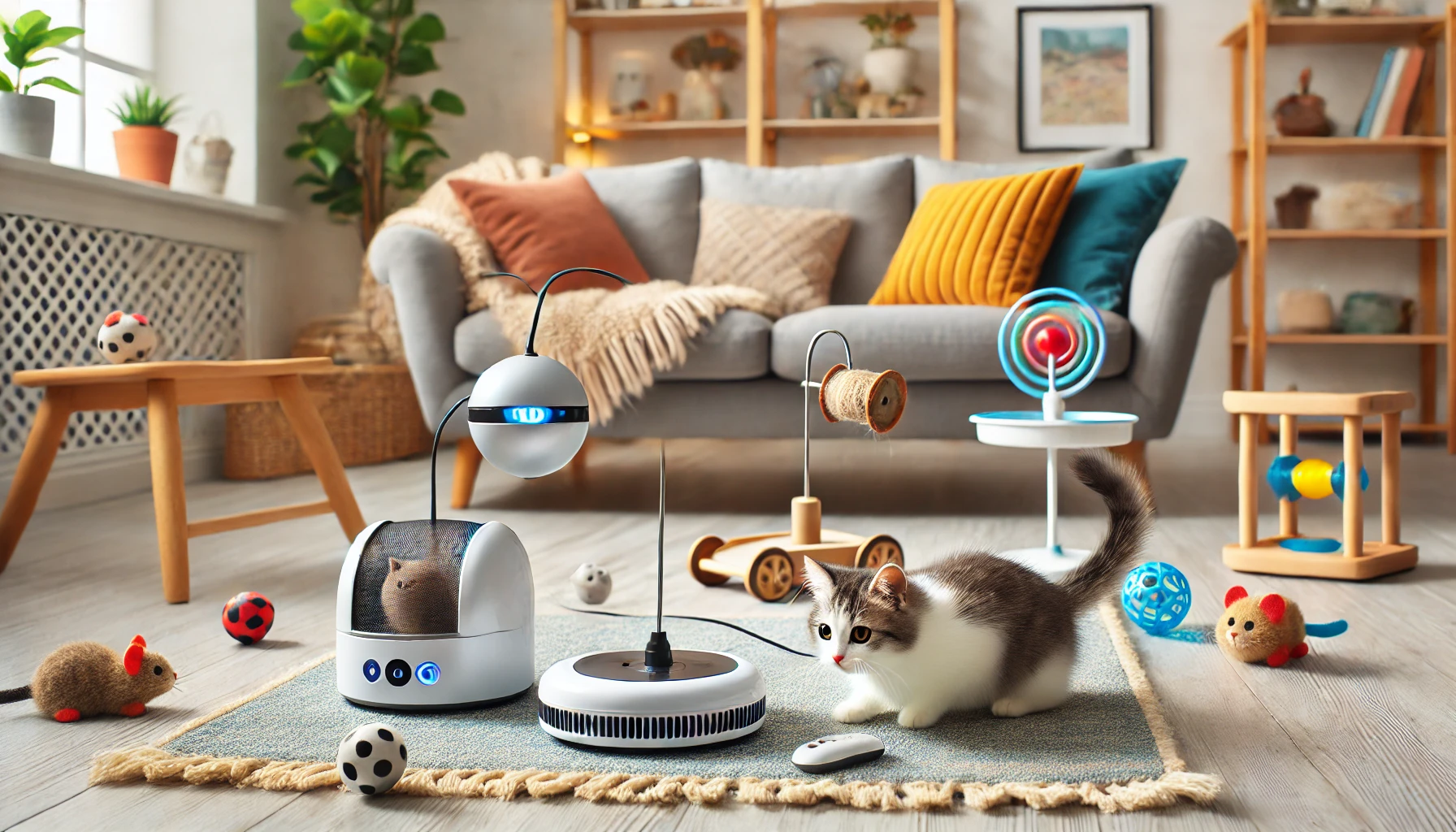
Automatic/Interactive Toys for Independent Play
Automatic toys are designed for independent play, allowing your cat to exercise even when you’re not around.
These toys can move on their own, flash lights, or make sounds to grab your cat’s attention.
Automatic laser toys, motorized balls, and robotic mice are examples of fitness toys that keep your cat entertained and active throughout the day, even when you’re busy or away.
These toys are especially useful for cats that need constant stimulation or easily get bored.
- Automatic laser toys: Keep your cat busy chasing and catching even when you’re not there.
- Motorized toys: Move unpredictably, keeping your cat excited and active for longer periods.
Different types of fitness toys, from interactive to automatic, cater to various needs and preferences, keeping your cat healthy and engaged.
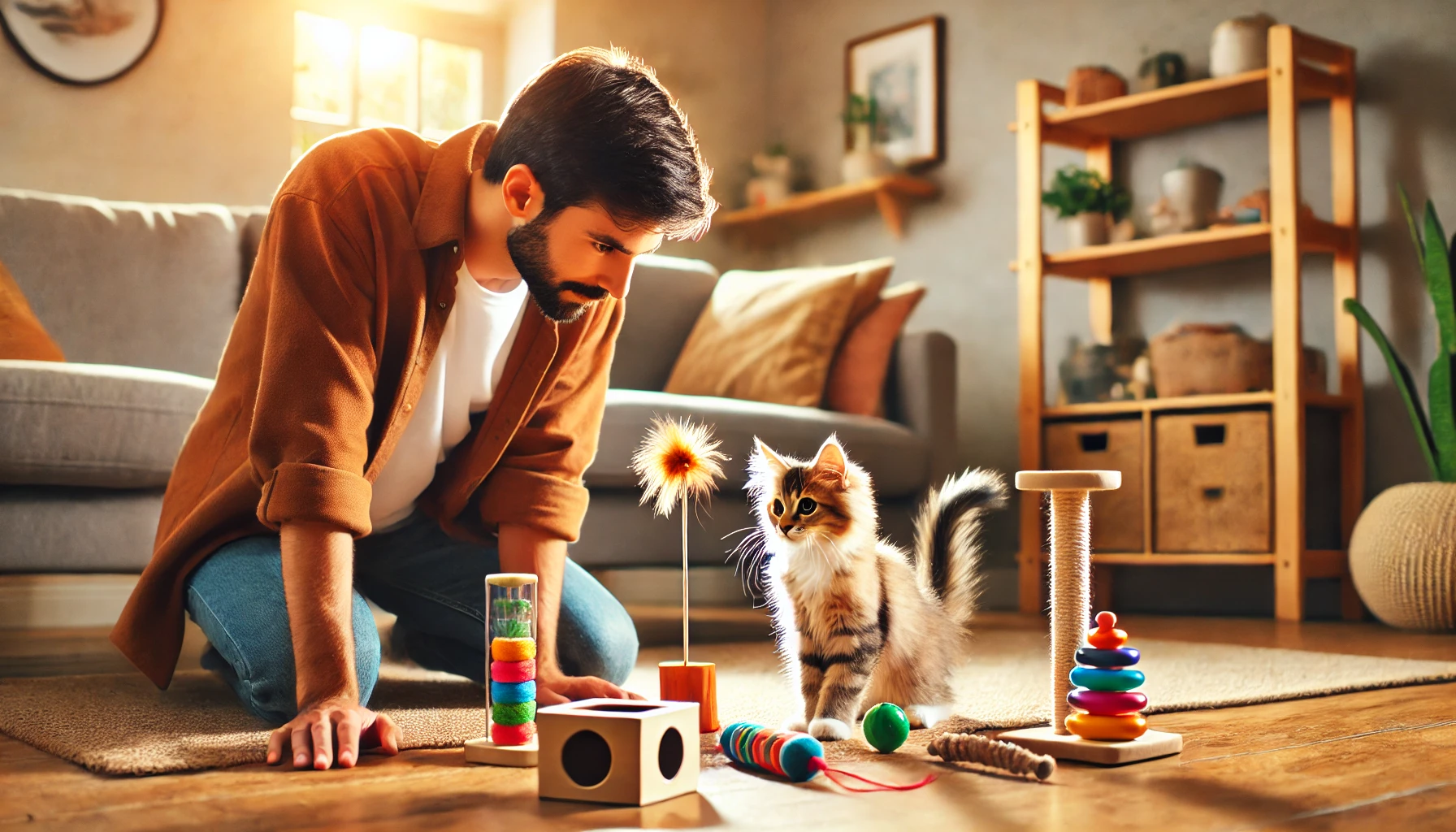
How to Introduce Fitness Toys to Your Cat
Introducing your cat to fitness toys is an exciting yet rewarding process that needs to be done patiently and strategically.
While cats are naturally curious, they are also cautious with new objects.
Therefore, it should be a gradual and positive process.
Timing, environment, and method all play a crucial role in whether your cat enjoys and embraces the fitness toys you provide for their exercise and enjoyment.
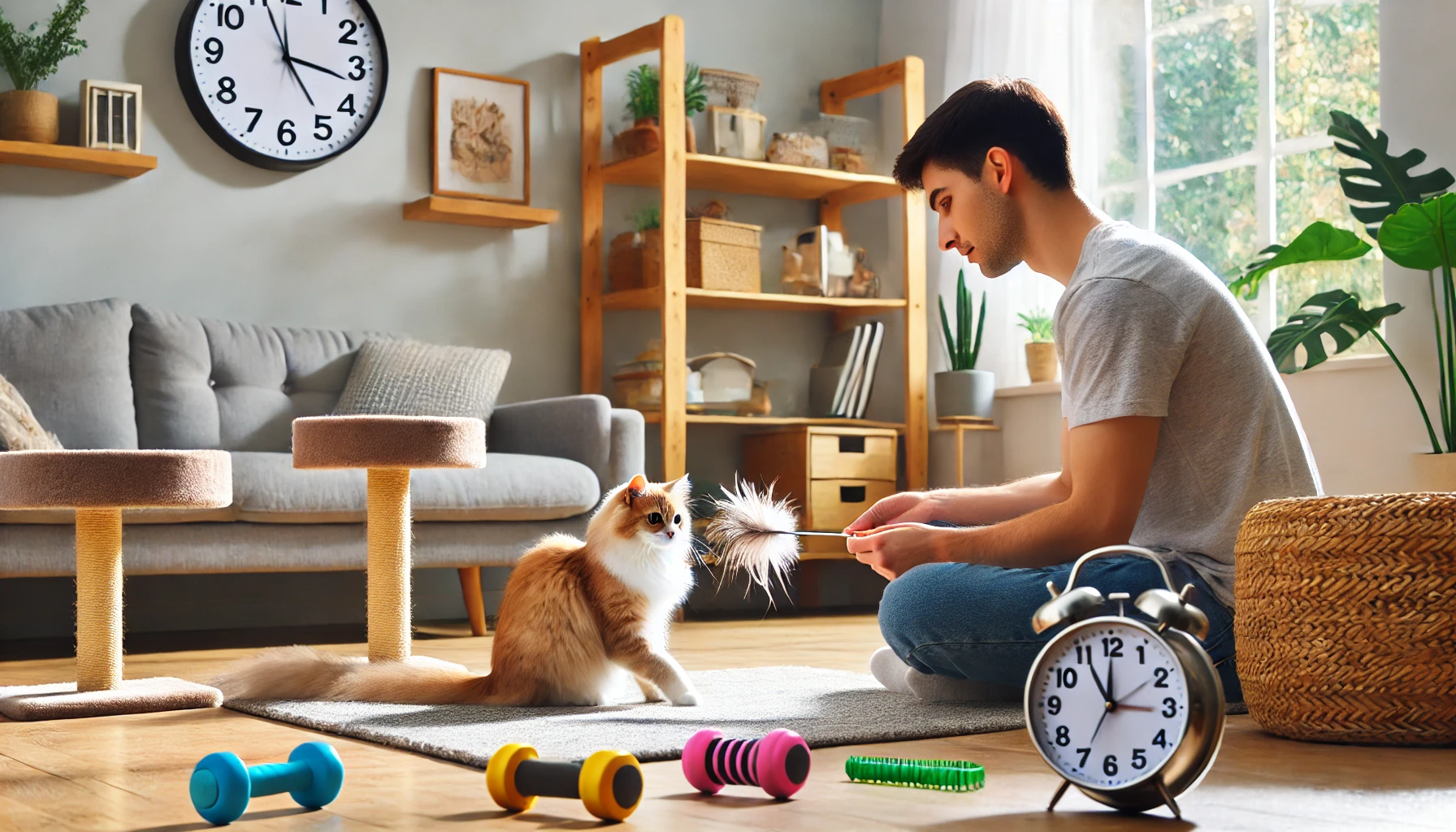
Creating a Play Routine
Cats are creatures of habit, and they thrive on routine.
Getting them accustomed to a new fitness toy is best done by establishing a playtime schedule.
Start with introducing play sessions at the same time, either in the morning or evening, and increase the length as your cat becomes more comfortable with the toys.
This routine will help your cat associate that particular time of day with fun and activity, making them more likely to interact with the toys.
- Play in Sessions: Start with short sessions and gradually extend them as your cat shows interest.
- Timing is Everything: Play with your cat before meals, when they are naturally active, or in the evening.
- Rotate Toys: Keep your cat engaged by varying fitness toys to prevent boredom.
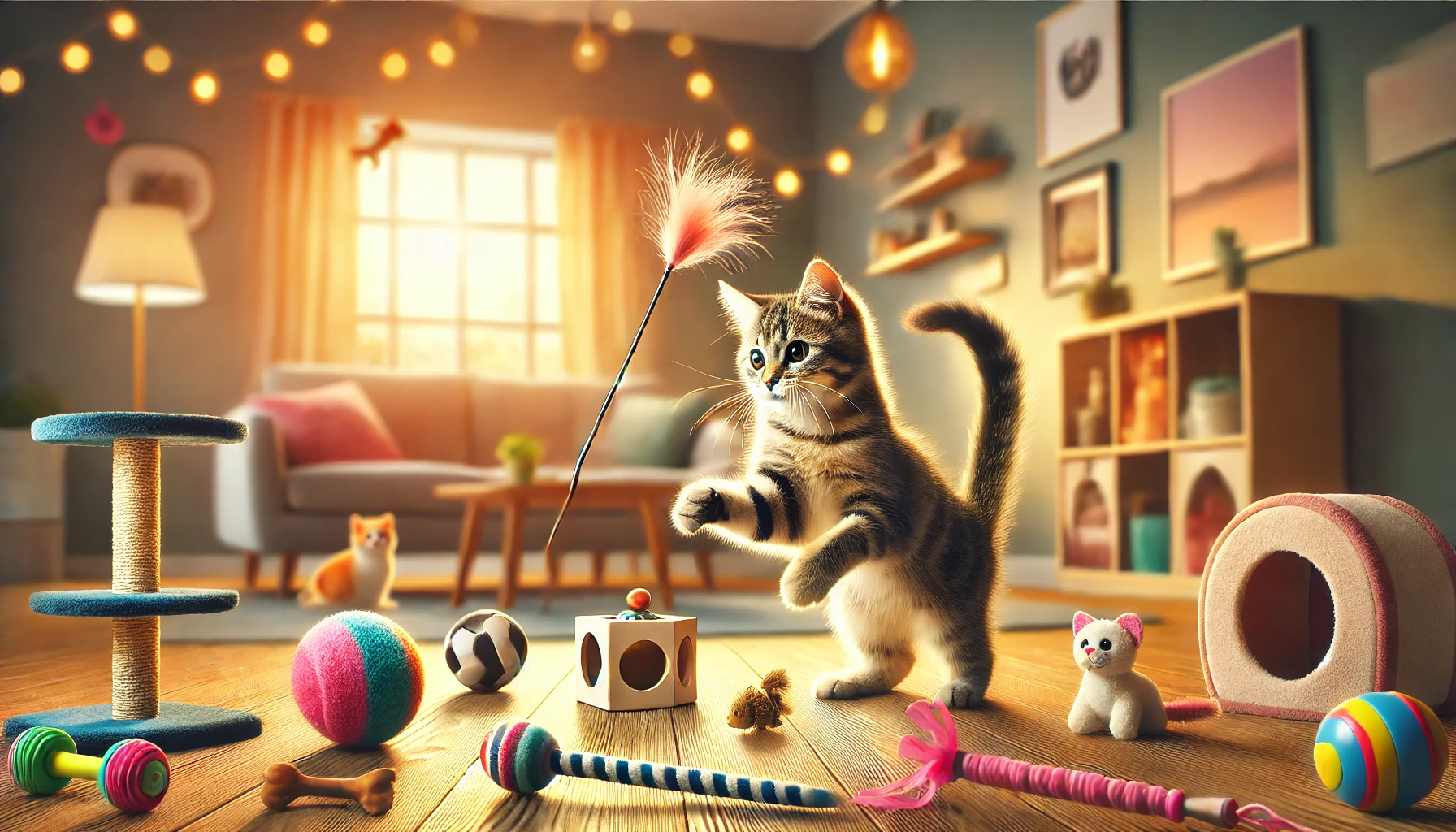
Keeping Cats Interested in Their Toys: Tips
Not every cat will be immediately attracted to a new toy, so it’s important to gauge their response and adjust accordingly.
Some cats are fascinated by chasing toys, while others are more stimulated by puzzle toys that challenge them mentally.
Knowing what your cat enjoys will help you choose toys that keep them active.
Additionally, rotating your fitness toys regularly can help prevent boredom, as cats can lose interest in the same toys over time.
- Treats as Rewards: Pair new toys with treats to encourage play and create positive associations with the activity.
- Incorporate Your Cat’s Favorite Activities: If your cat enjoys climbing, introduce toys that encourage jumping and pouncing.
- Reward Play: After each play session, reward your cat with attention or a treat to reinforce good behavior.
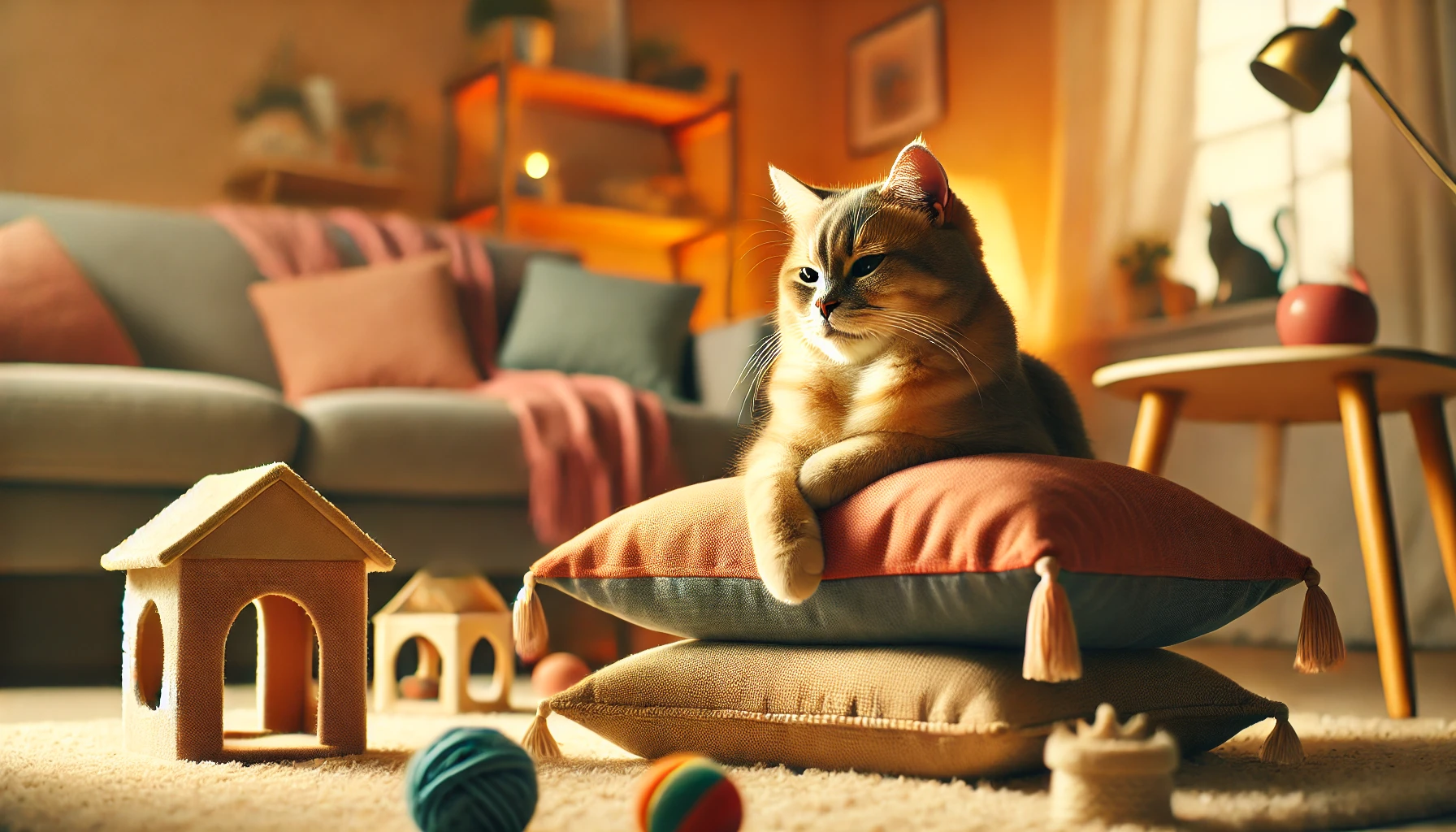
Avoiding Overstimulation During Playtime
While it’s great to keep your cat active, too much stimulation can lead to frustration or aggression.
Always observe your cat’s body language during playtime.
If they become overly excited or show signs of stress, such as flattened ears or a swishing tail, it’s time for a break.
Let your cat dictate the pace of play and provide them with a quiet environment where they can retreat if needed.
- Watch for Signs of Overstimulation: A swishing tail or flattened ears can indicate overstimulation.
- Take Breaks: Allow rest time between play sessions to prevent burnout.
- End on a Positive Note: Try to conclude each play session with a success, such as your cat ‘catching’ the toy, leaving them satisfied.
Introduce fitness toys gradually to your cat, establish a routine, and ensure play sessions are fun and stress-free.
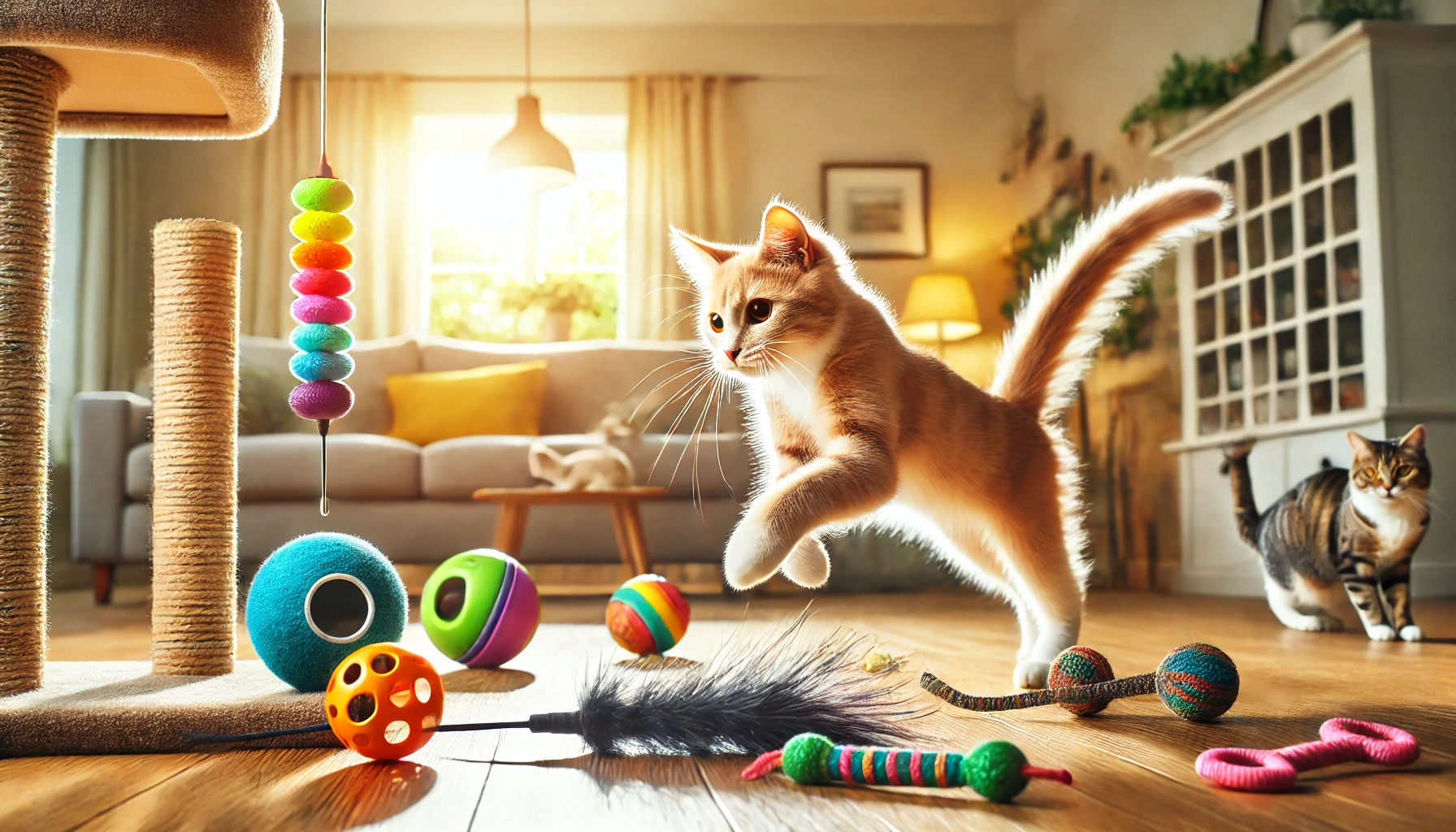
Benefits of Regular Exercise with Fitness Toys
Regular exercise is as important to cats as it is to humans.
Fitness toys not only make your cat physically active but also provide various mental and emotional benefits.
Regular use of fitness toys ensures a more enjoyable and healthy life for your cat.
In addition, regular play sessions with these toys have a profound positive impact on your feline friend, improving their overall health, regulating their weight, and providing mental stimulation.
Let’s discover some key benefits of helping your cat exercise regularly through fitness toys.
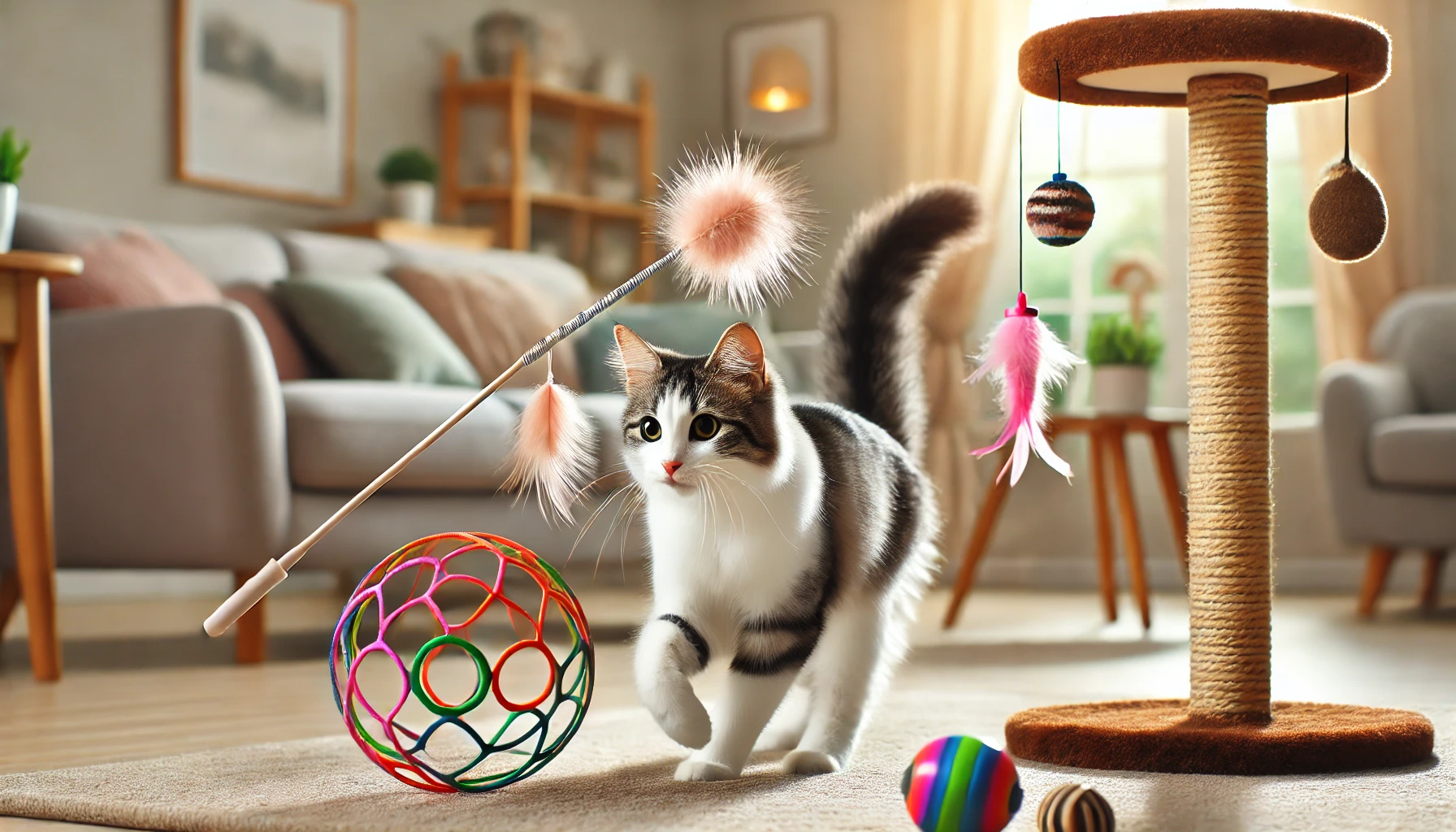
Physical Health: Weight Management and Avoidance of Obesity
One of the main advantages of using fitness toys is that they help your cat maintain a healthy weight.
Most indoor cats do not get the natural dose of exercise that outdoor cats do.
Fitness toys promote active play, which helps burn calories and manage weight.
Regular exercise helps prevent obesity, a common issue in indoor cats, and reduces the risk of related health conditions such as diabetes and heart disease.
- Burning calories: Fitness toys keep your cat active by helping to burn extra calories.
- Preventing obesity: Regular play reduces the risk of health problems associated with weight issues, such as diabetes.
- Improving agility: Toys that encourage running, jumping, and pouncing help maintain your cat’s agility and flexibility.
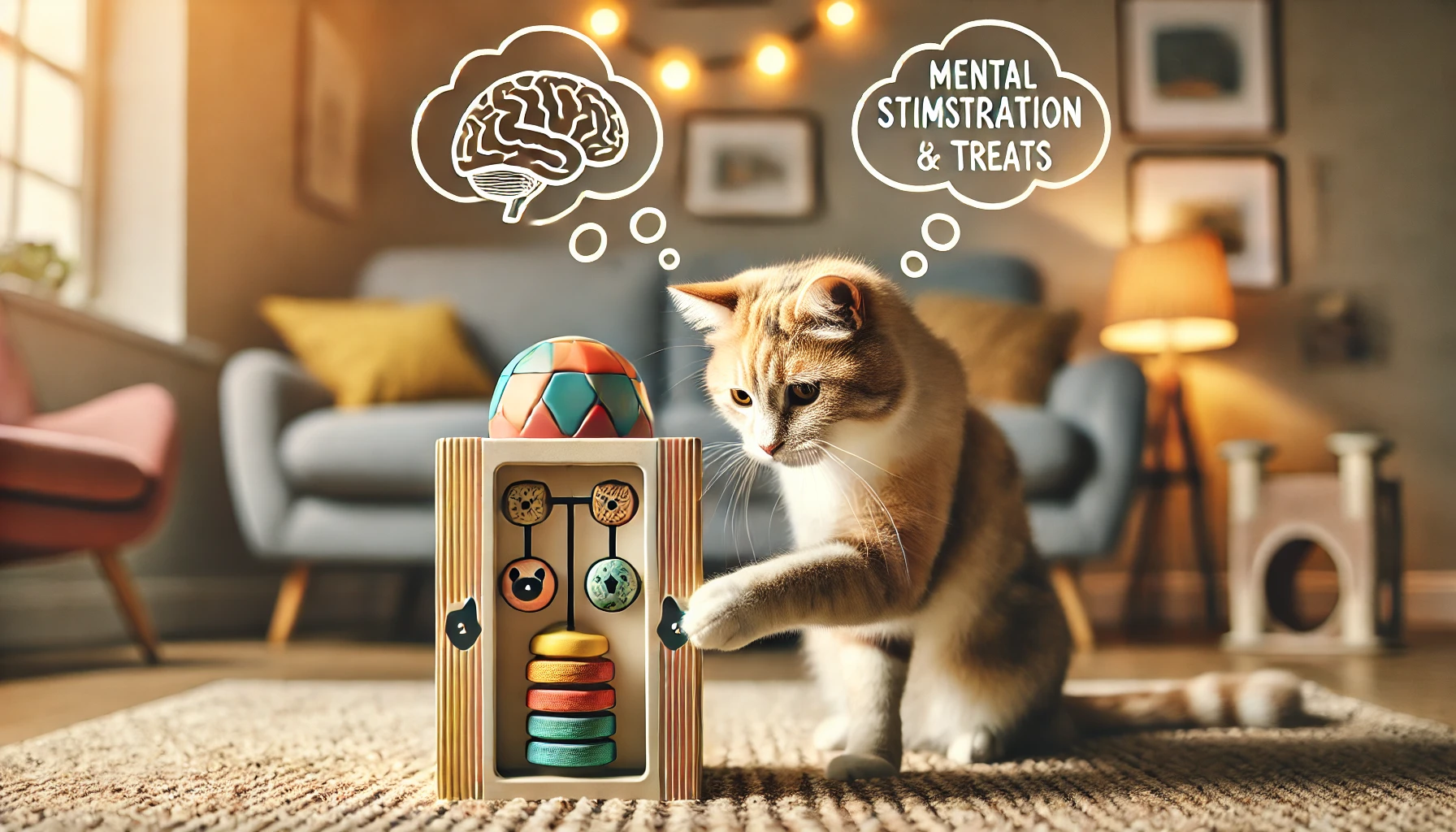
Mental Stimulation and Reducing Boredom
Like humans, cats get bored if they don’t receive enough mental or physical stimulation.
Boredom in cats can lead to destructive behaviors such as excessive scratching, chewing, and grooming.
Fitness toys provide your cat with the mental stimulation they need to stay sharp.
Puzzle toys, in particular, challenge your cat’s problem-solving skills, keeping their mind engaged and reducing boredom.
- Problem-solving: Puzzle toys challenge your cat’s brain and help keep them mentally sharp.
- Reducing boredom: Interactive play prevents your cat from becoming destructive out of boredom.
- Exploration: Prey-simulation toys encourage your cat to explore their surroundings and engage their natural curiosity.
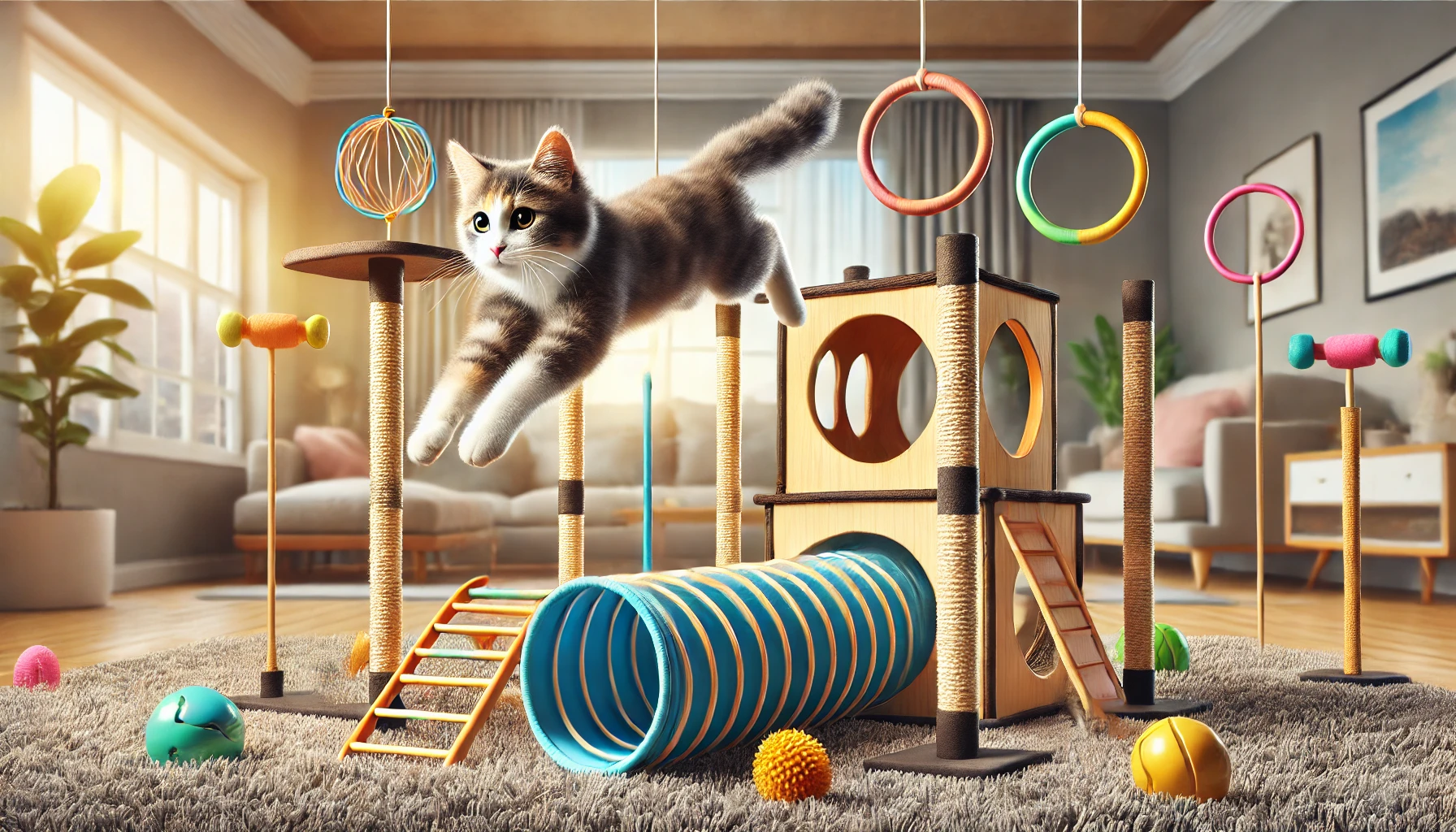
Enhancing Your Cat’s Agility and Coordination
In addition to helping your cat stay physically fit, fitness toys also improve their agility and coordination.
Toys that encourage your cat to leap, chase, and pounce promote flexibility and muscle strength.
This is especially important for older cats, as it helps prevent stiffness and maintains joint health.
Regular use of fitness toys can help your cat retain their agility and stay playful well into their senior years.
- Improving coordination: Fitness toys that challenge quick reflexes enhance your cat’s agility.
- Maintaining flexibility: Regular movement keeps your cat limber and reduces the risk of joint problems.
- Promoting muscle strength: Play that involves running, jumping, and climbing builds your cat’s muscle tone.
Regular exercise through fitness toys improves your cat’s physical health, mental sharpness, and agility, keeping them happy and healthy.
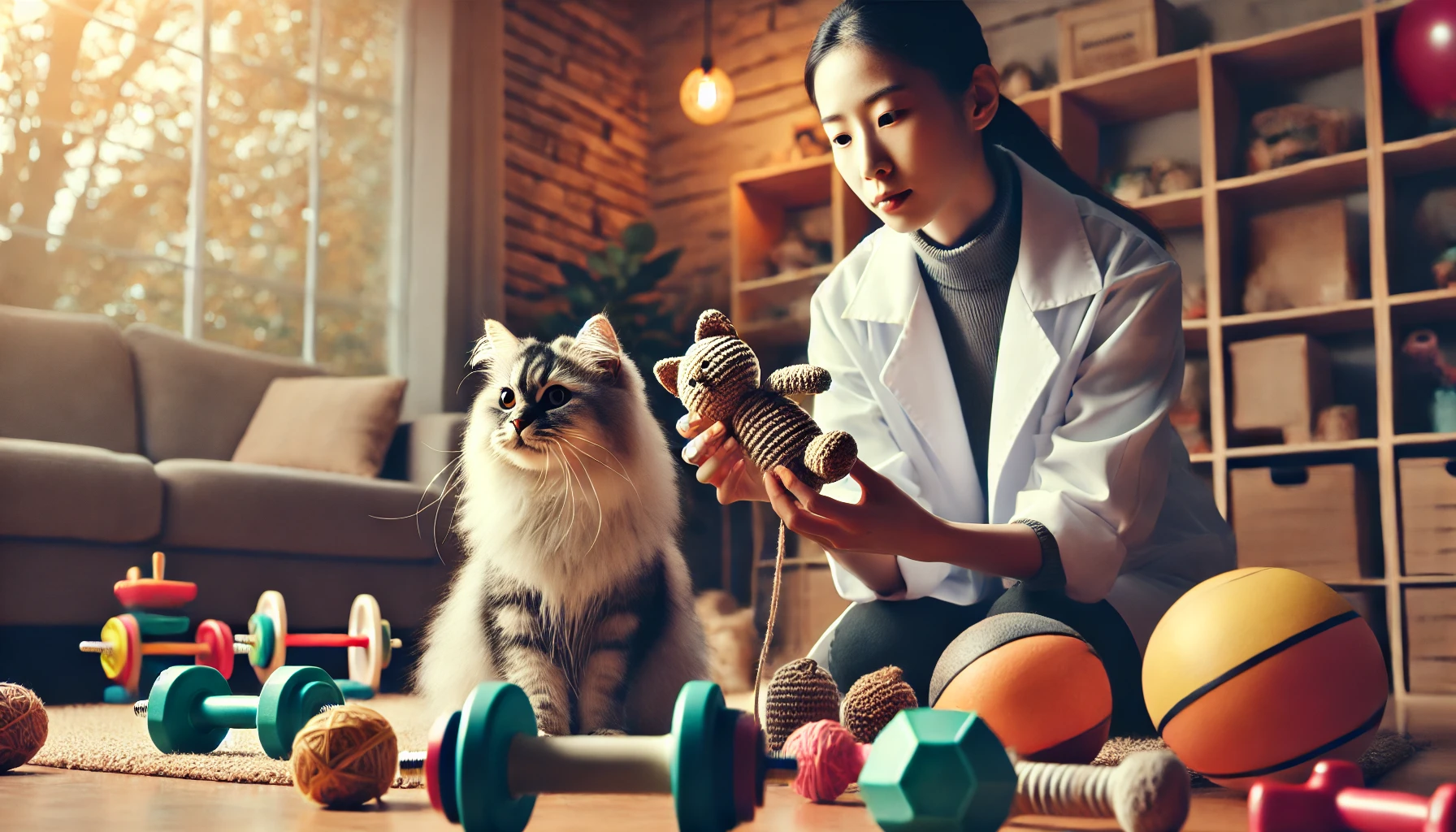
Safety Precautions in Using Fitness Toys
Safety precautions are essential to ensure that fitness toys are safe for your cat to play with.
While fitness toys can bring enormous benefits to the health and well-being of your cat, it’s important to take steps to prevent injuries.
From choosing the right materials to monitoring playtime, safety precautions help avoid risks and make sure your cat enjoys their fitness toys without any danger.
This section covers some key safety tips every cat owner should keep in mind when using fitness toys.
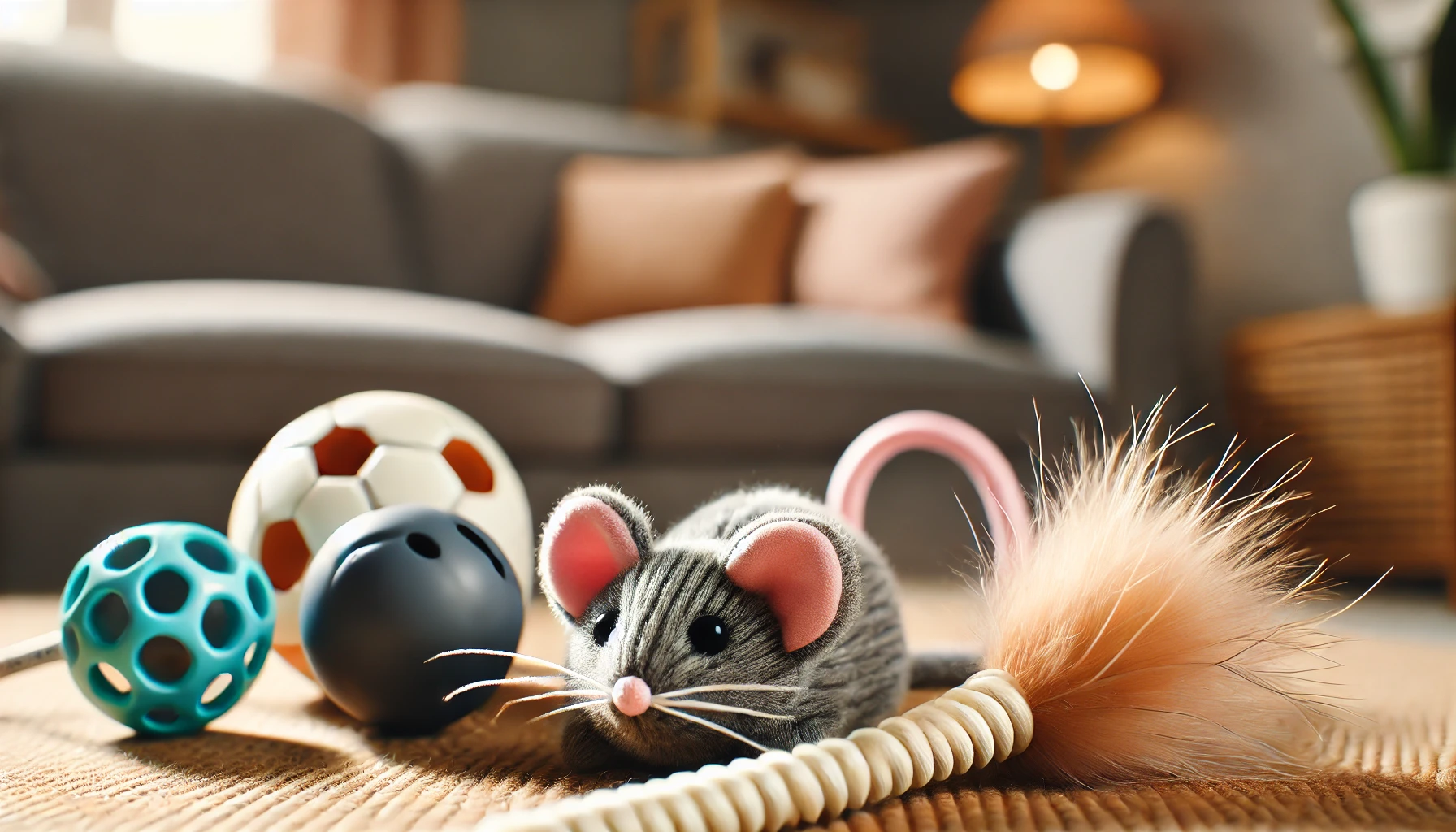
Choosing Safe Materials for Toys
When selecting fitness toys for your cat, you must ensure they are made from non-toxic and durable materials.
Many toys may have small detachable parts or strings that could choke your cat if swallowed.
Always choose toys specifically designed for pets and avoid those with easily detachable parts.
Plush toys, for instance, should be well-stitched with no buttons or small objects that your cat could swallow.
- Non-toxic materials: Use pet-friendly materials to avoid exposing your cat to dangerous chemicals.
- Durable construction: Select high-quality toys that can withstand your cat’s claws and teeth without falling apart.
- Avoid small parts: Avoid toys with loose strings or small parts that can be easily swallowed.
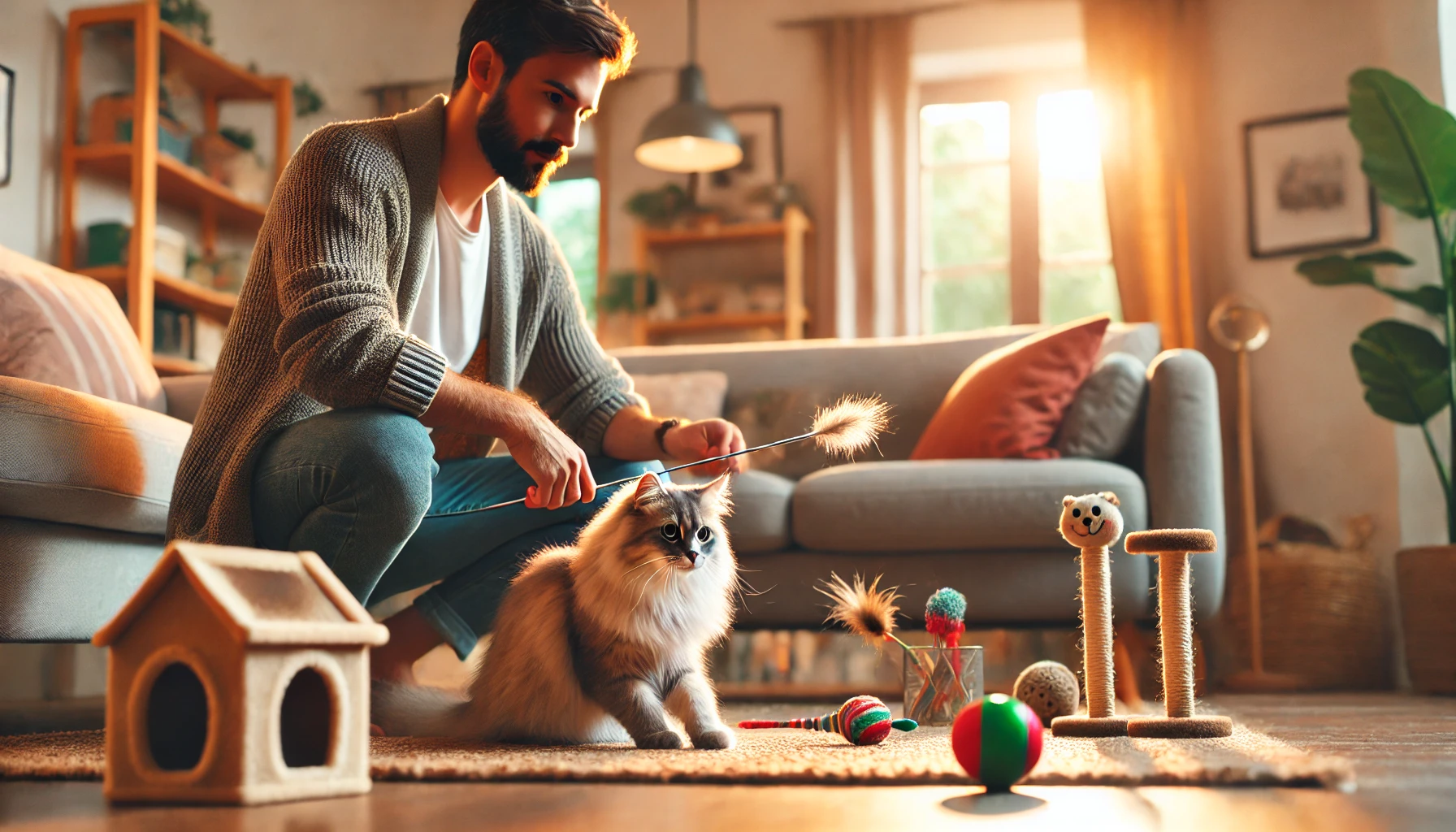
Supervising Playtime to Prevent Injuries
Even though fitness toys are designed for independent play, it’s always a good idea to supervise your cat during playtime, especially when using new or unfamiliar toys.
Cats can become overexcited or too rough with their toys, which can result in unintended injuries.
Supervision allows you to observe your cat and assess whether they are playing safely.
If needed, you can intervene to prevent accidents.
Monitoring your cat also helps you understand how they interact with the toy and whether any adjustments are necessary.
- Observe play: Watch your cat while they play with the toy to ensure they are playing safely.
- Avoid injuries: Stop your cat if they become too rough or if the toy appears damaged.
- Limit unsupervised play: Always supervise your cat when introducing new toys to ensure safe play.
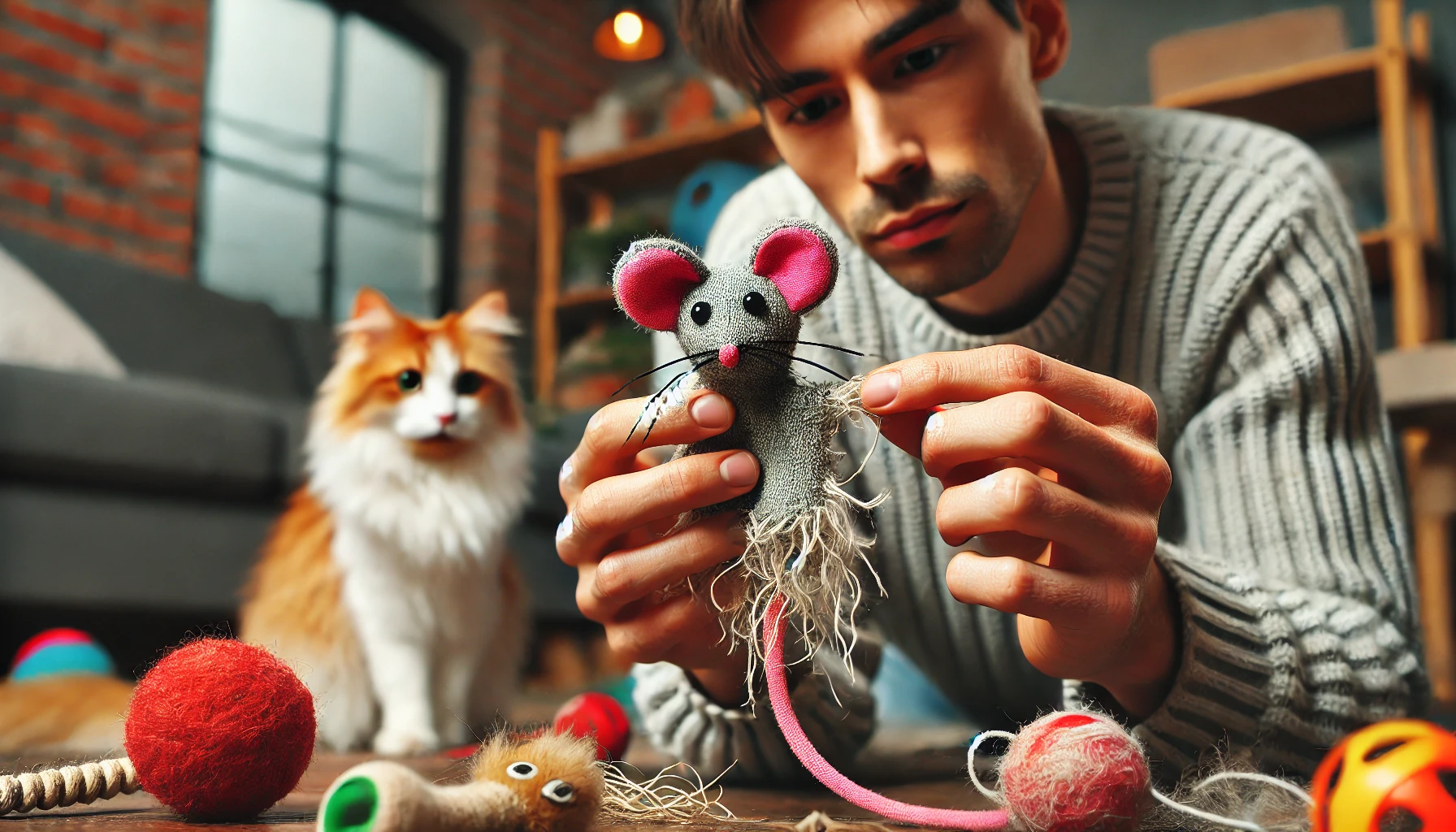
When to Replace Worn-Out Toys
Over time, even the most well-made fitness toys wear out from regular use.
Worn-out toys with exposed stuffing, broken parts, or frayed edges can become dangerous for your cat.
It’s important to inspect your cat’s toys regularly for damage and replace them when necessary.
By doing so, you minimize the risk of your cat ingesting harmful materials or getting injured while playing with a damaged toy.
- Inspect toys regularly: Look for signs of wear and tear, such as frayed edges or broken parts.
- Replace worn-out toys: Discard toys that have become hazardous due to excessive wear and tear.
- Safety first: Ensure your cat’s safety by providing well-maintained, intact toys at all times.
Always ensure your cat’s toys are made from safe materials, supervise play, and replace worn-out toys to prevent injuries.
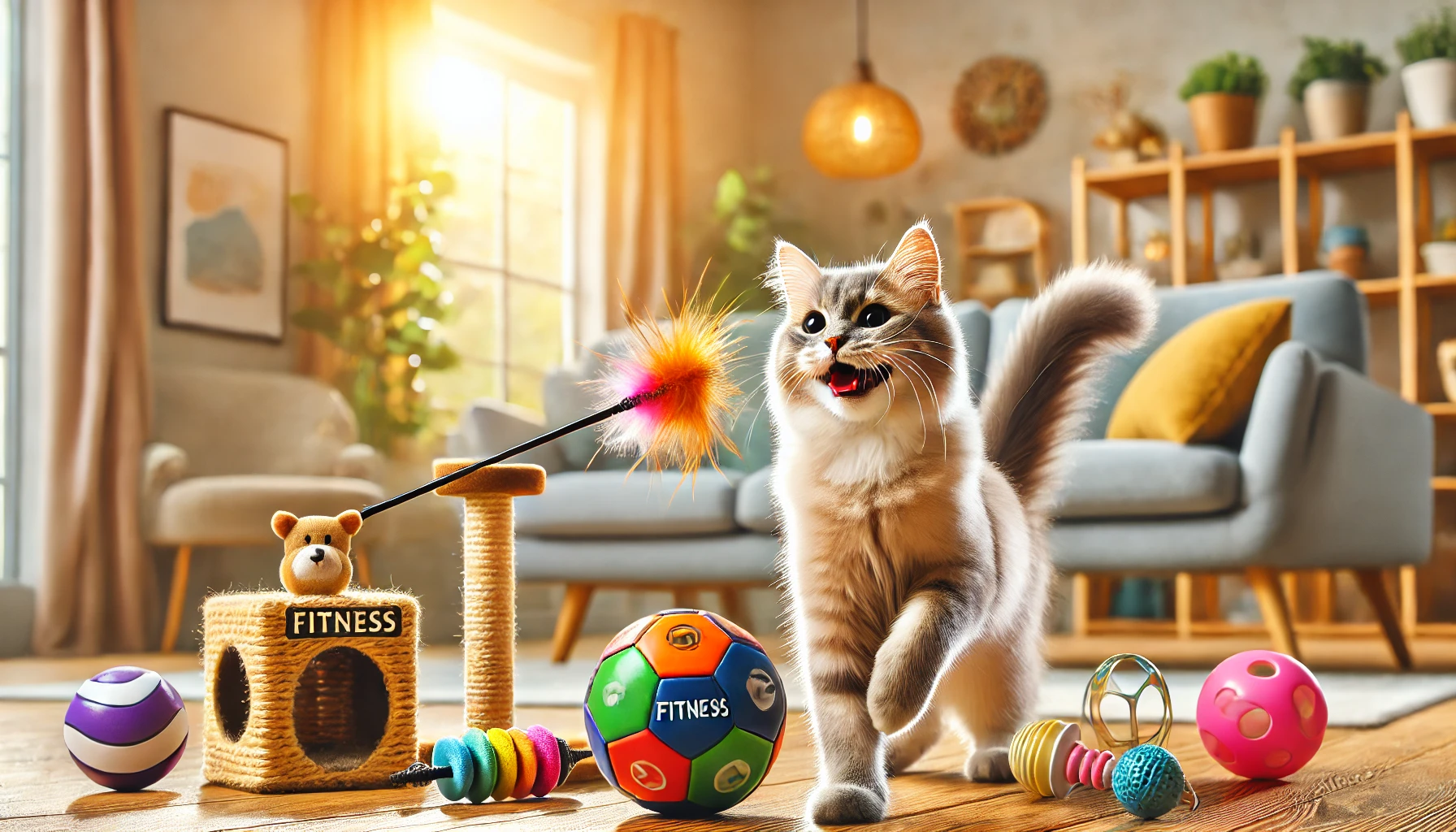
Fitness Toys for the Health and Well-being of Your Cat
Increasing daily activity for your cat through the use of fitness toys has significant implications for their overall health.
Fitness toys provide necessary exercise, stimulating your cat’s natural instincts to get them running around and moving.
These toys are perfect for a young, high-energy cat or an older one that may need a bit more motivation.
Introducing fitness toys can make a noticeable difference in their quality of life.
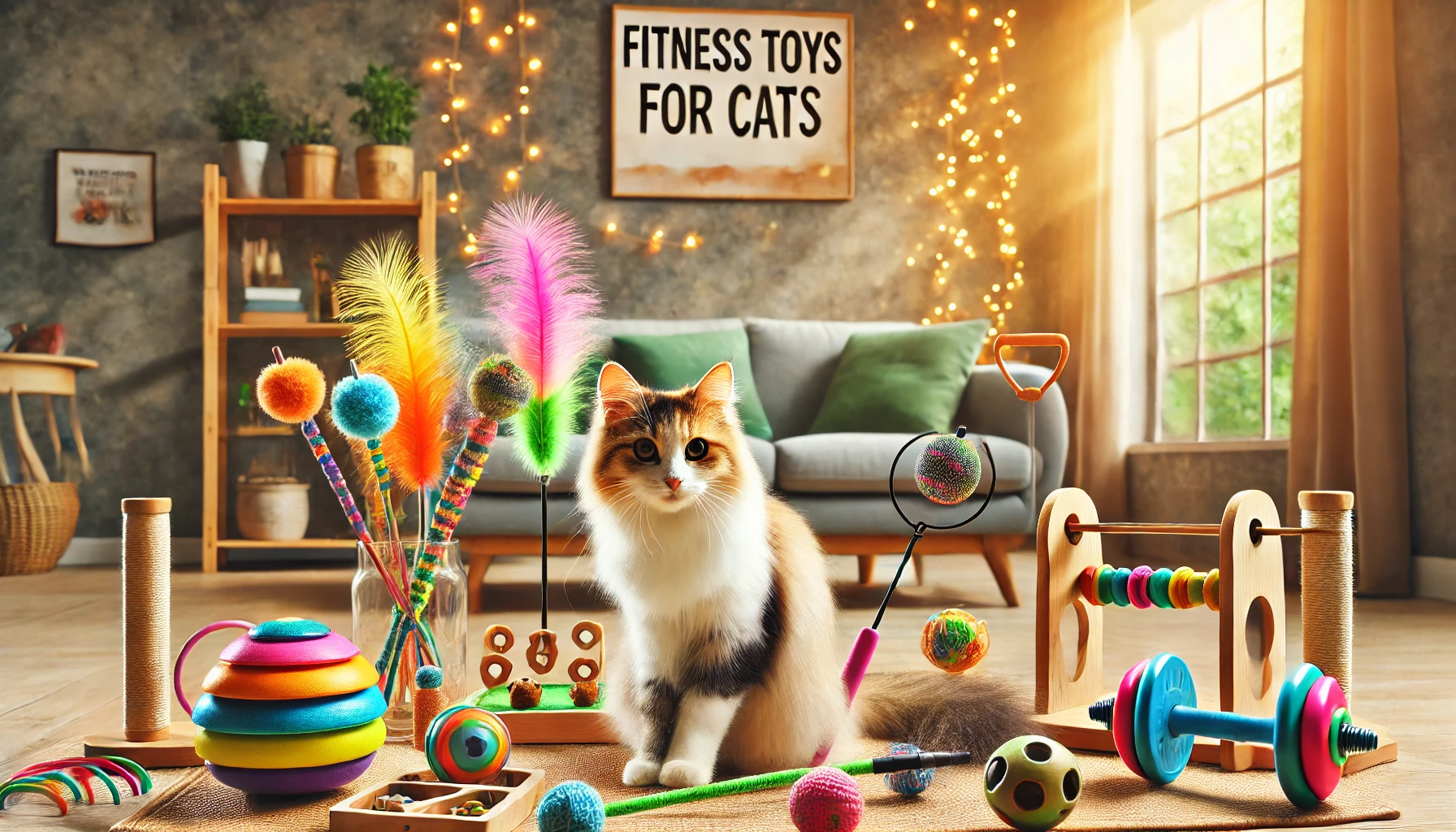
Summary of Benefits of Fitness Toys
Fitness toys are an excellent way to keep your cat healthy, both physically and mentally.
By giving your cat fitness toys, you provide them with a way to maintain their ideal weight and reduce the risk of obesity, which can lead to complications like diabetes and heart problems.
Additionally, these toys contribute to your cat’s agility and coordination, keeping them flexible and active even as they age.
- Physical health: Regular exercise with fitness toys helps maintain your cat’s proper weight and prevents obesity-related problems.
- Mental stimulation: Puzzle toys and interactive play keep boredom at bay and ensure your cat stays mentally sharp.
- Agility and coordination: Toys that encourage jumping, running, and pouncing help maintain your cat’s agility and muscle strength.
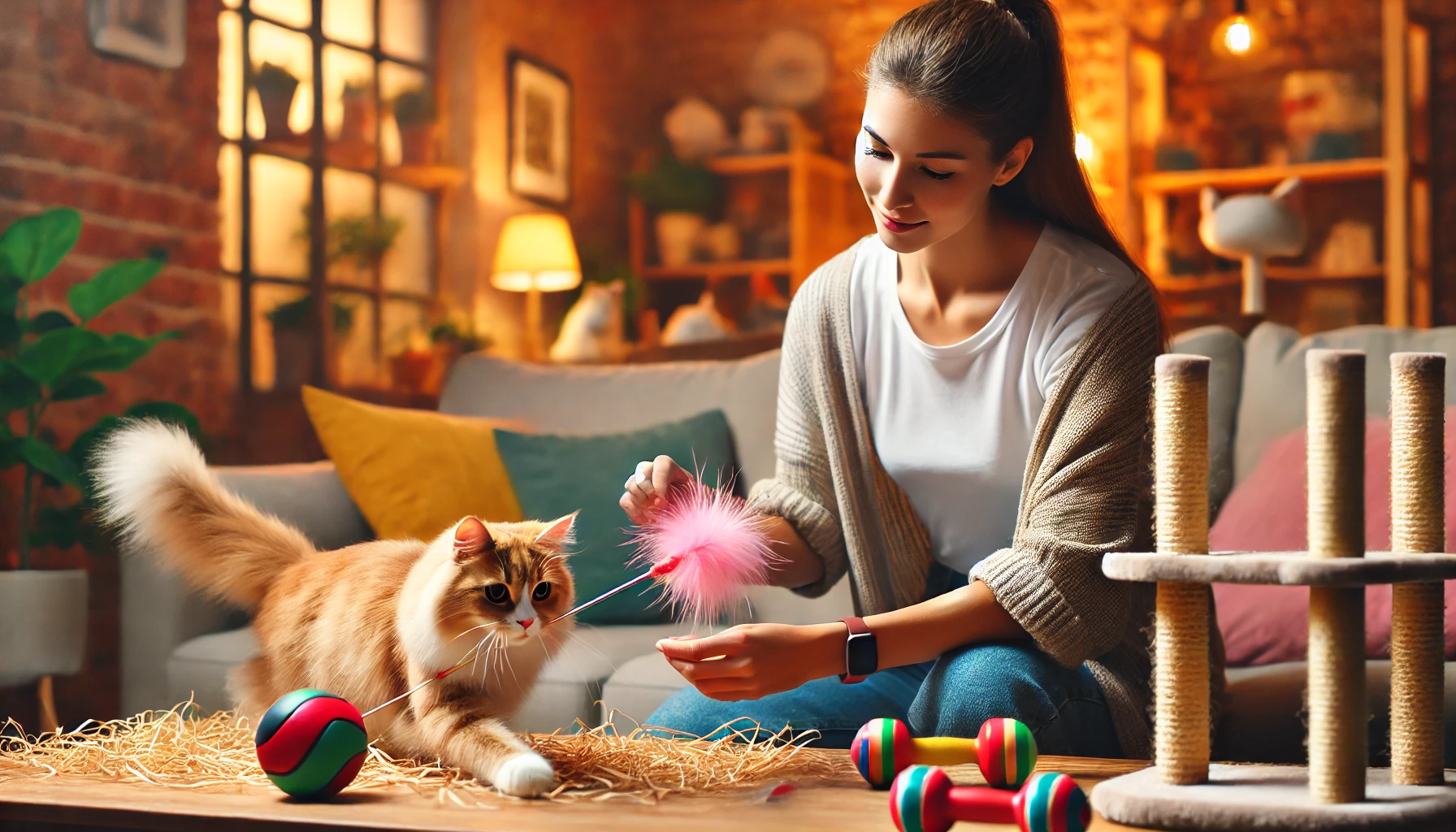
Ensuring Safe Play with Fitness Toys
While fitness toys bring many benefits, it’s important to take a few safety precautions.
Choosing toys made from non-toxic, durable materials helps prevent injuries, and supervising your cat during playtime ensures they are playing safely.
Regularly inspecting and replacing worn-out toys reduces the risks and keeps your cat’s playtime both safe and enjoyable.
- Select safe materials: Ensure that you choose pet-safe materials that won’t be toxic for your cat.
- Supervise play: Observe your cat’s behavior closely during playtime, especially when introducing new toys.
- Replace damaged toys: Regularly check toys for wear and tear, and replace them as necessary.
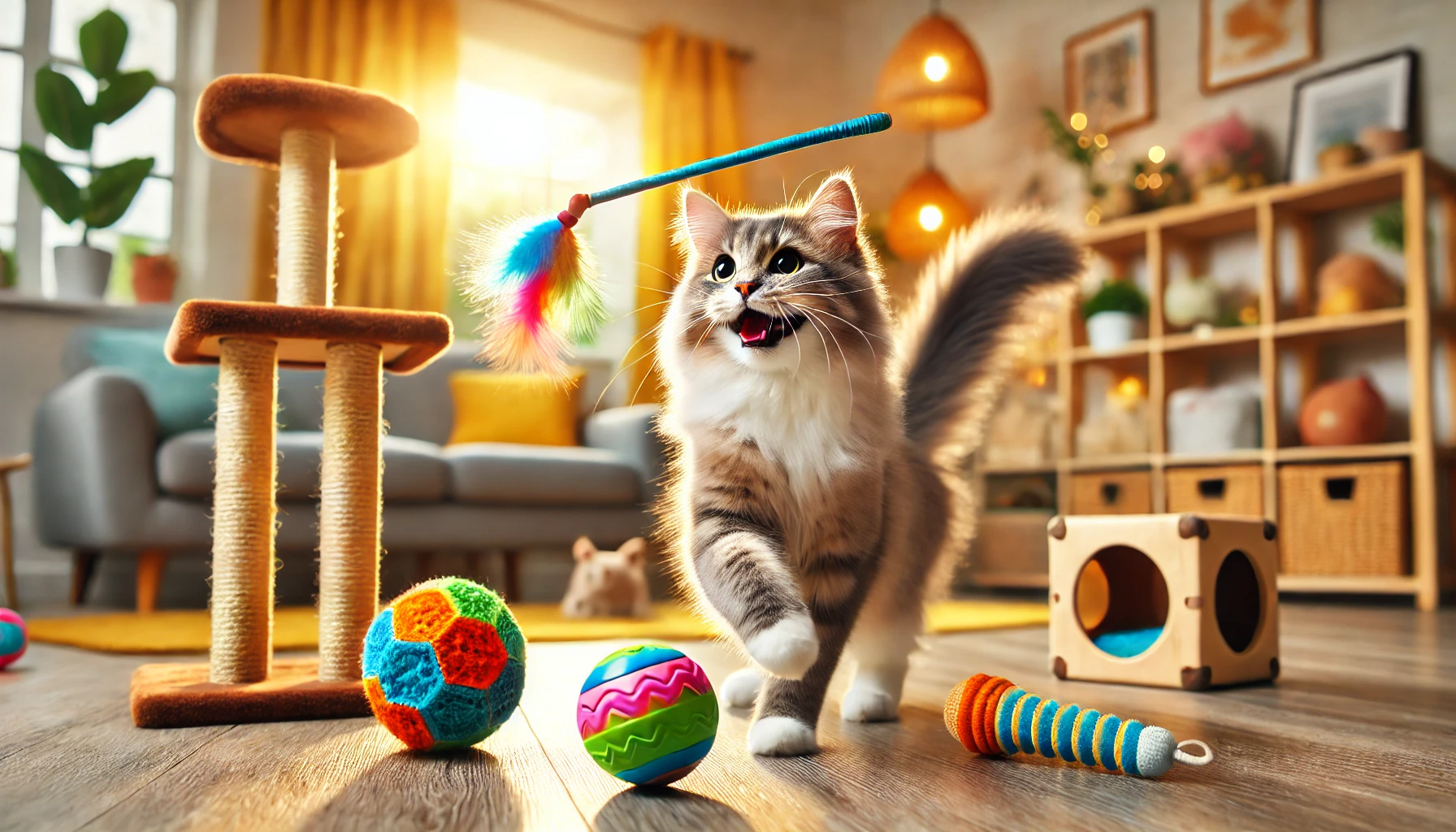
Conclusion: Keeping Your Cat Active and Happy with Fitness Toys
In conclusion, fitness toys are an easy and effective way to enhance your cat’s life.
By keeping them physically fit, mentally engaged, and safe during playtime, you help increase their overall happiness and longevity.
Introducing fitness toys will keep your cat entertained while strengthening the bond between you and your furry friend.
Remember, every cat is different, so it’s important to find the fitness toys that suit them best.
Whether interactive toys, puzzle feeders, or automated devices, fitness toys are a worthwhile investment in your cat’s health and well-being.
Fitness toys contribute to your cat’s overall well-being by keeping them physically and mentally engaged, improving their health and happiness.
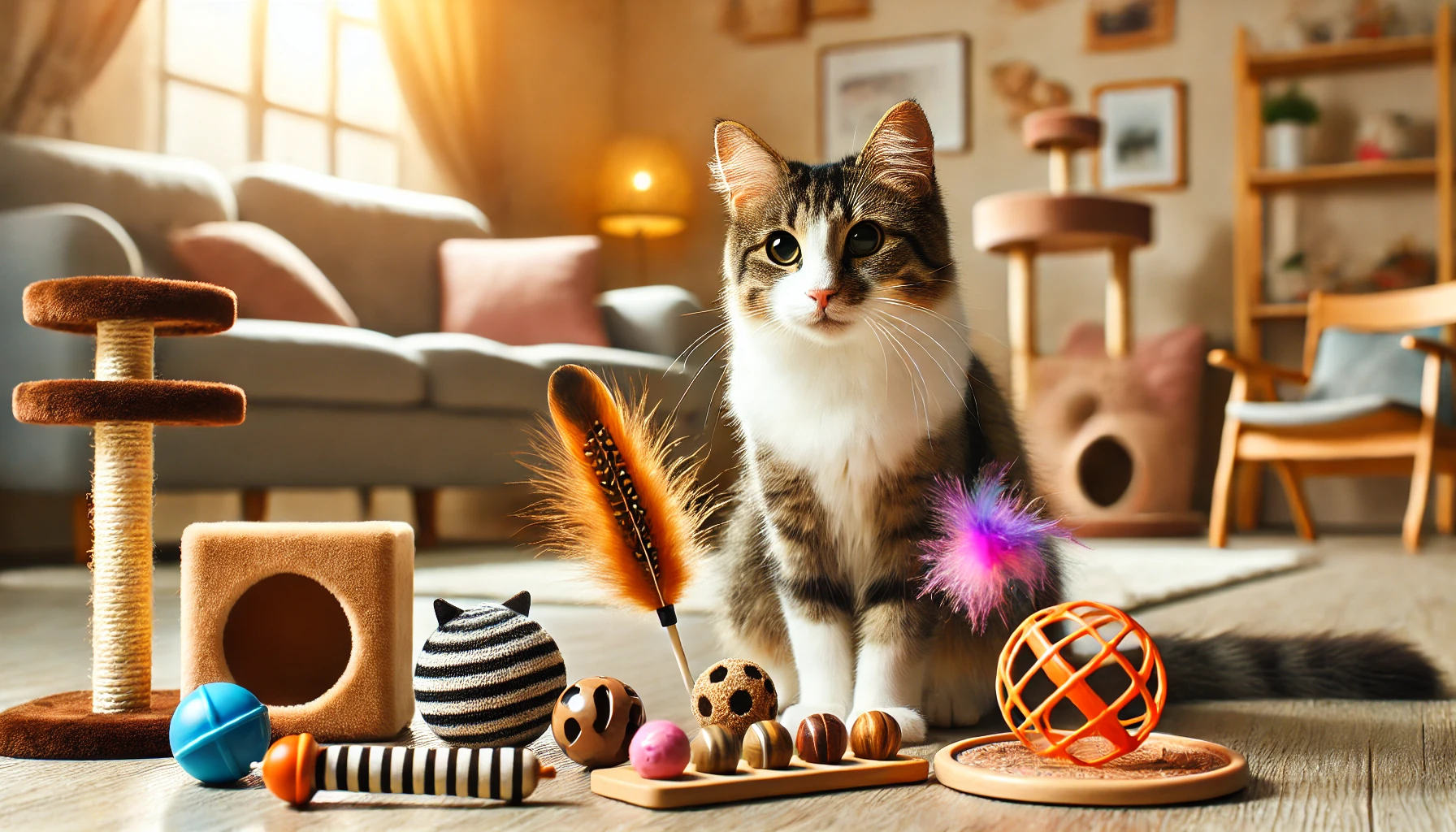
Frequently Asked Questions About Fitness Toys for Cats
Below are some of the most frequently asked questions regarding the use of fitness toys for cats.
These answers will help you better understand how fitness toys benefit your cat and how to ensure they are used effectively and safely.
What types of fitness toys are best for cats?
Examples of effective fitness toys include interactive feather wands, laser pointers, and puzzle feeders.
These toys stimulate both the mind and body of your cat, encouraging exercise and problem-solving, while allowing natural behaviors like chasing and pouncing.
How often should I use fitness toys with my cat?
It’s ideal to engage your cat with fitness toys every day for 20 to 30 minutes.
This provides sufficient physical exercise and mental stimulation, helping your cat stay healthy and avoid boredom or destructive behaviors.
Are fitness toys safe for all cats?
Generally, most fitness toys are safe for all cats, but ensure they are made from non-toxic materials.
Always supervise playtime, especially with new toys, and inspect toys regularly to prevent injuries or accidental ingestion of small parts.
How do fitness toys help prevent obesity in cats?
Fitness toys encourage physical activity, helping your cat burn calories and maintain a healthy weight.
Regular play reduces the risk of obesity-related health issues such as diabetes, while improving muscle tone and overall physical fitness.
Are fitness toys suitable for older cats?
Yes, fitness toys can benefit older cats by improving mobility, flexibility, and muscle strength.
Gentle toys, such as puzzle feeders, are perfect for senior cats, providing both mental stimulation and light physical activity.
When do I know it's time to replace a fitness toy?
Regularly check your cat’s toys for signs of wear such as frayed edges, broken parts, or exposed stuffing.
Replace any damaged toys immediately to prevent your cat from ingesting harmful materials or causing themselves injury.

